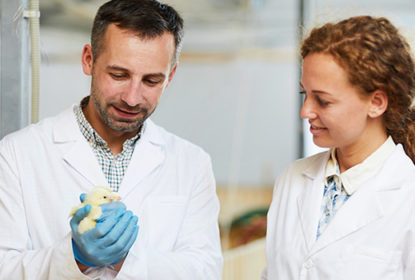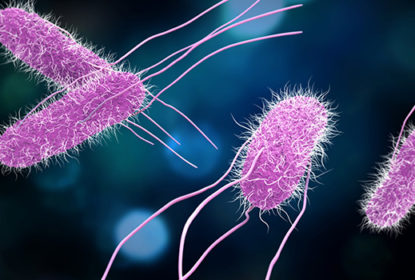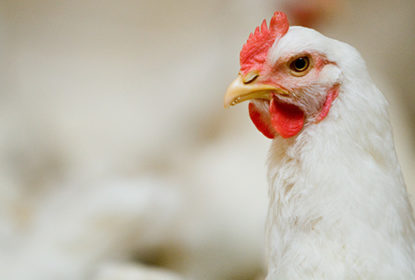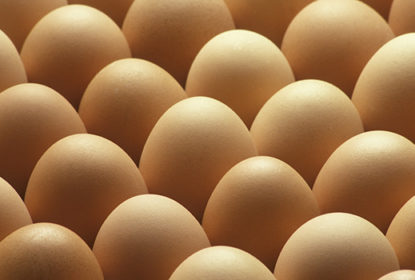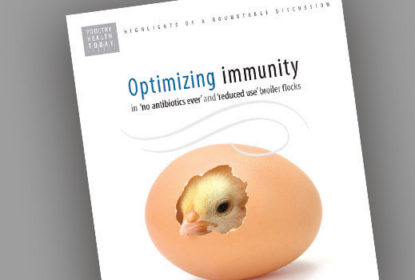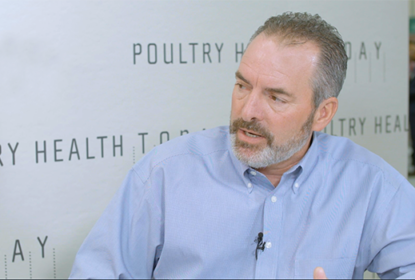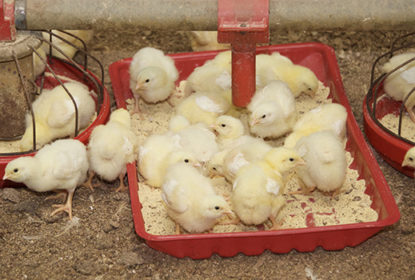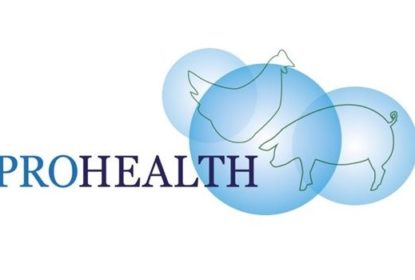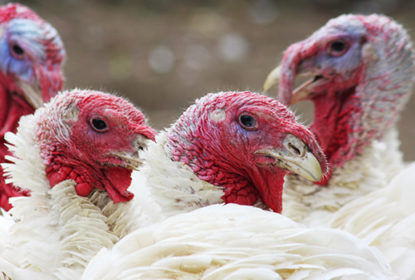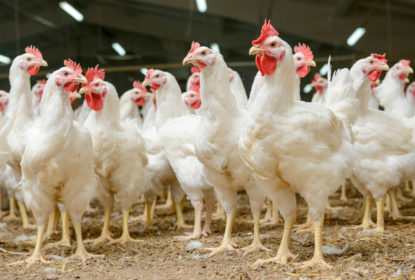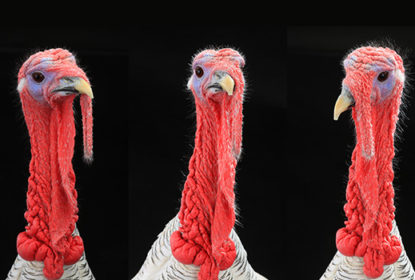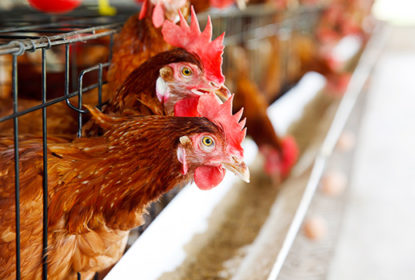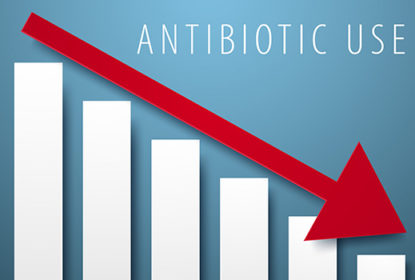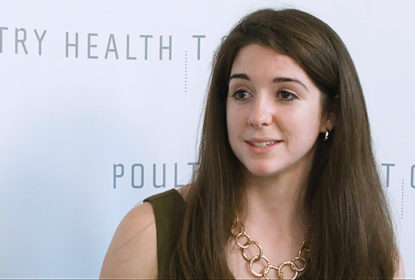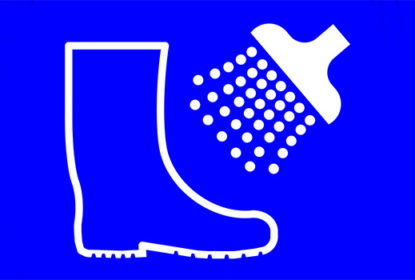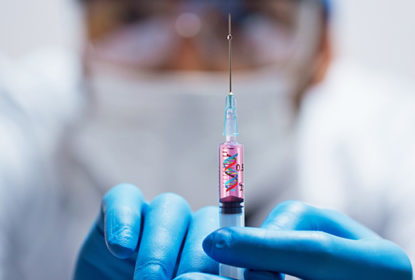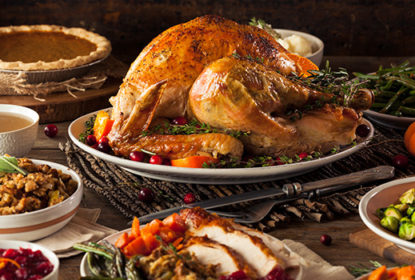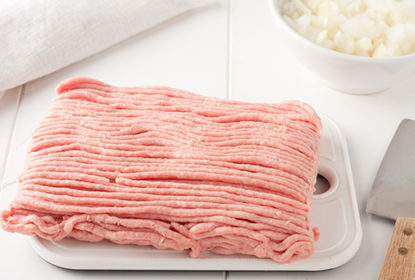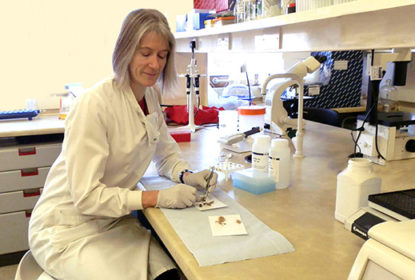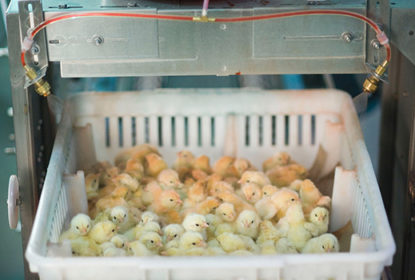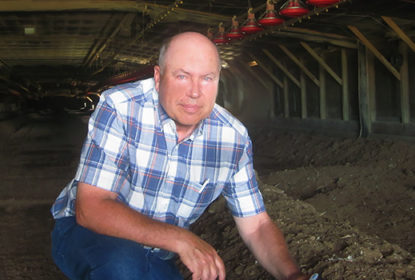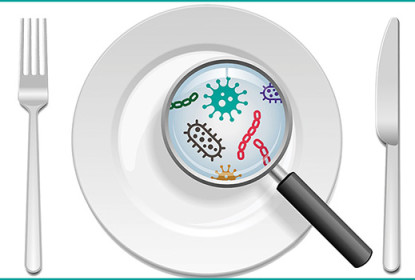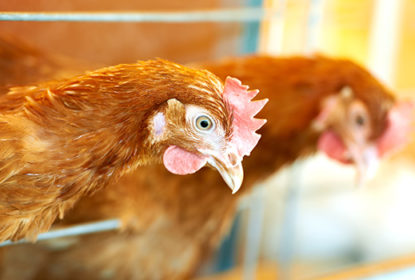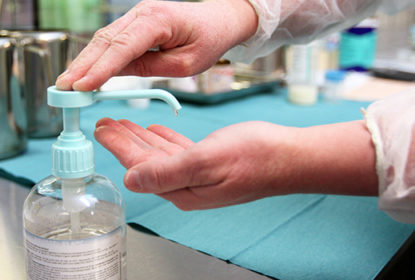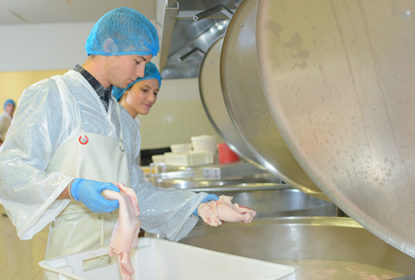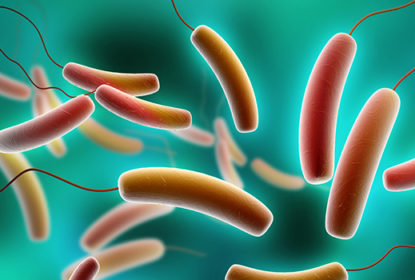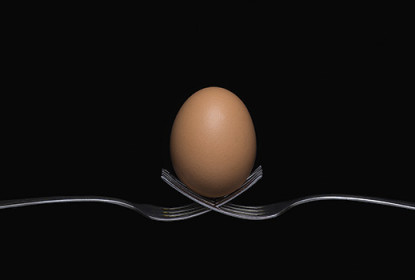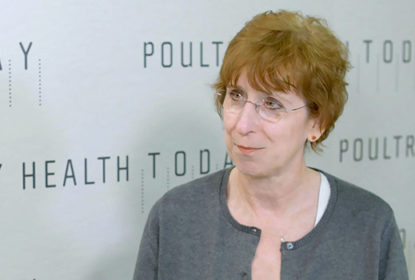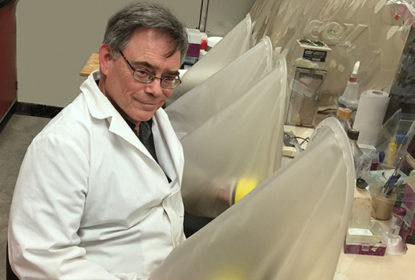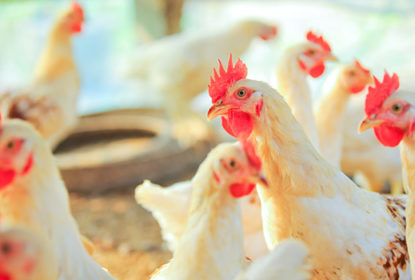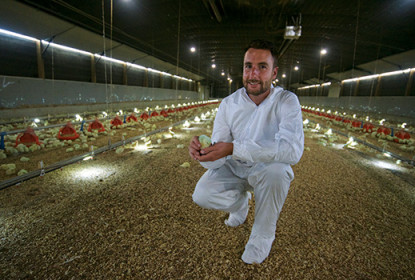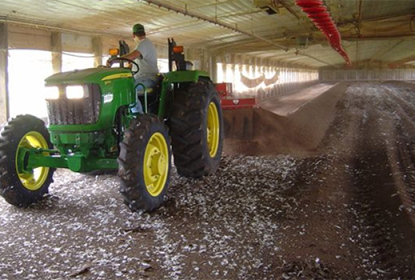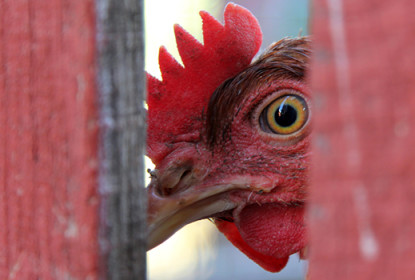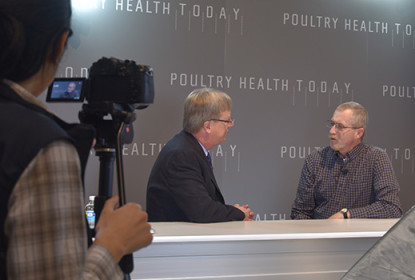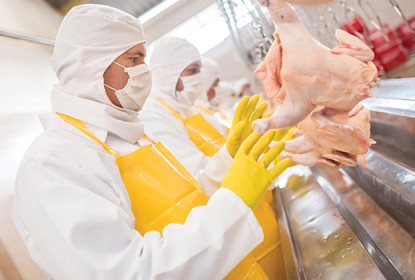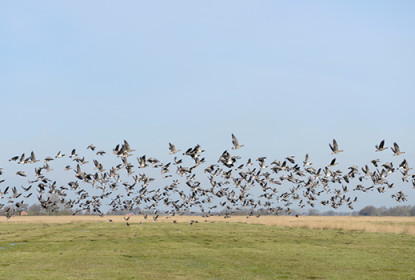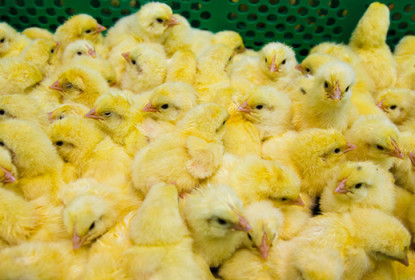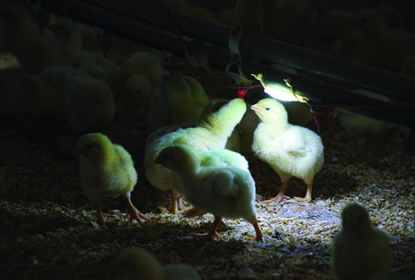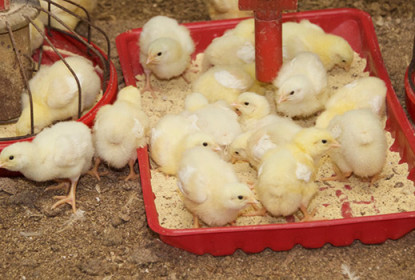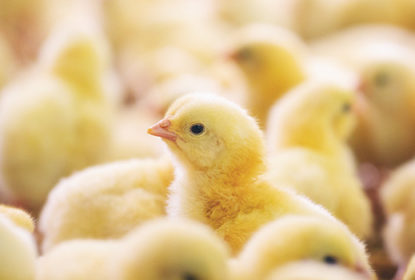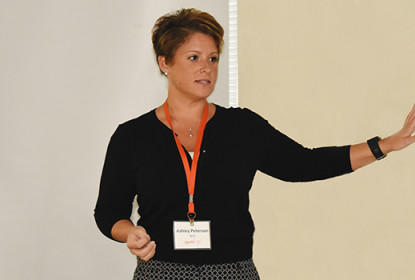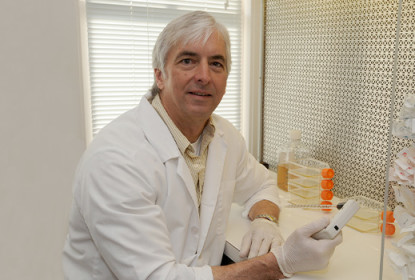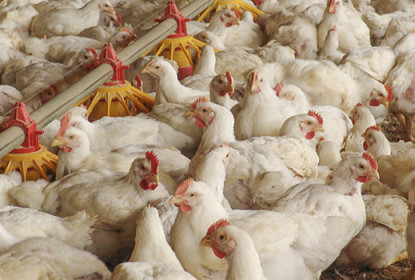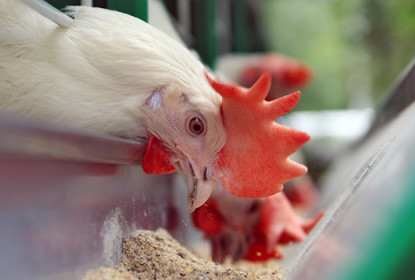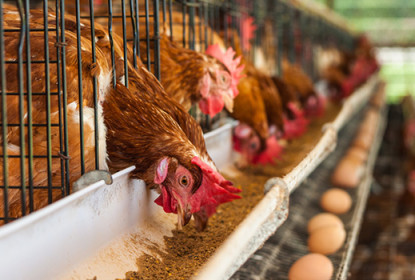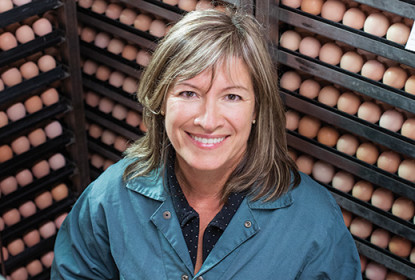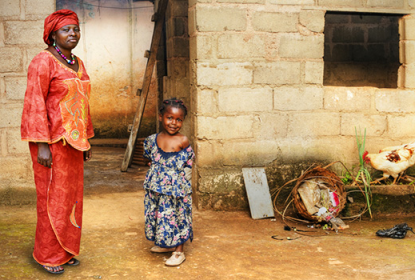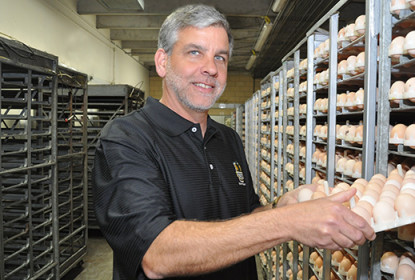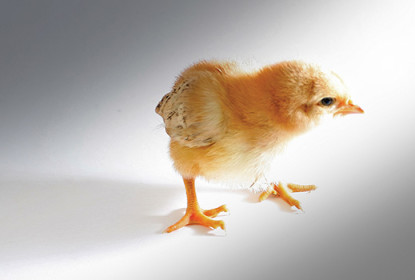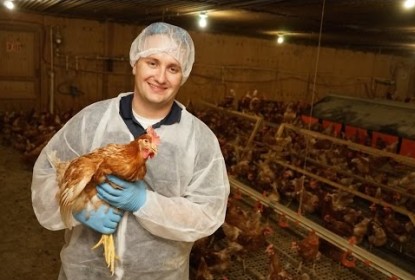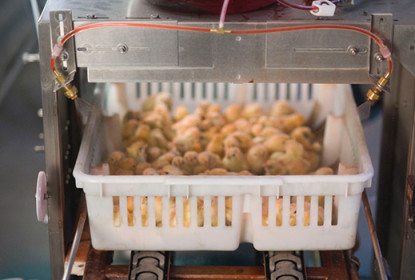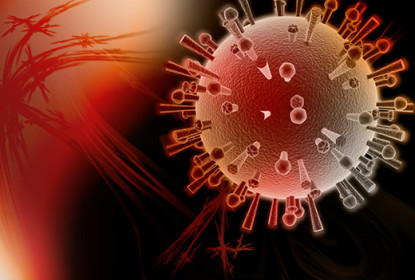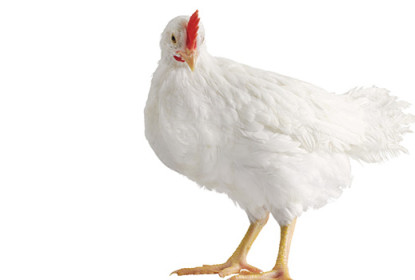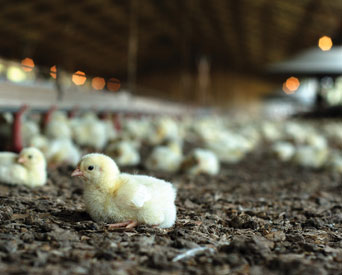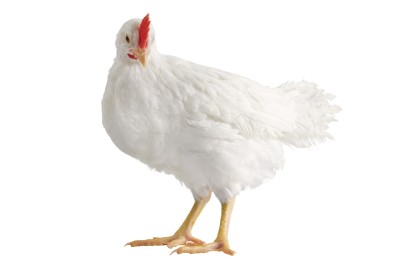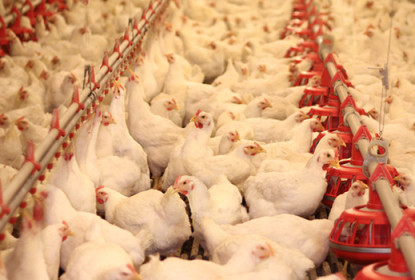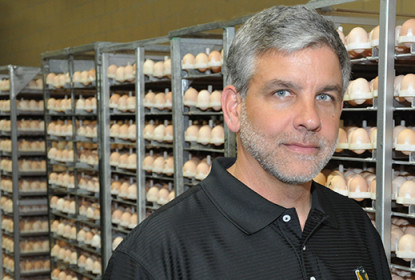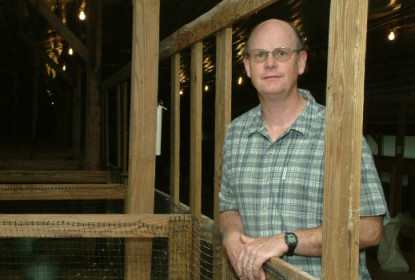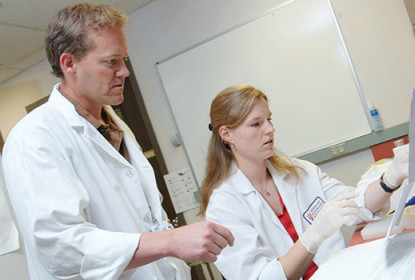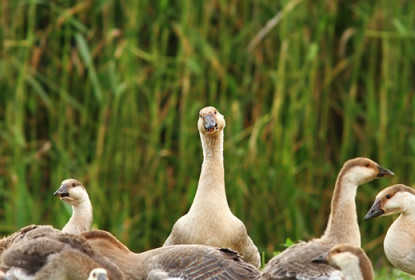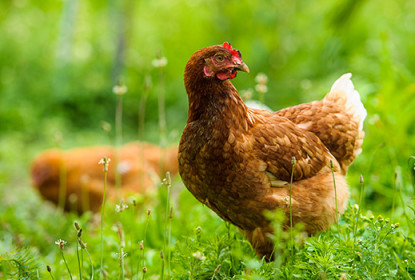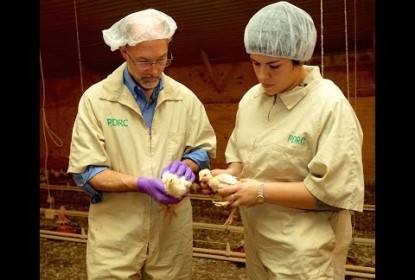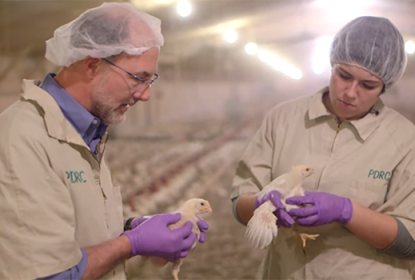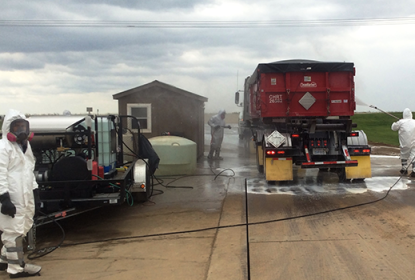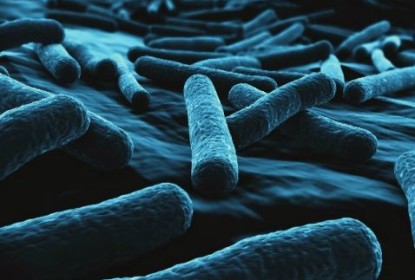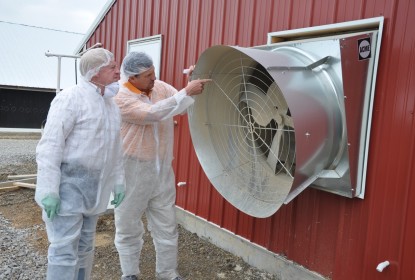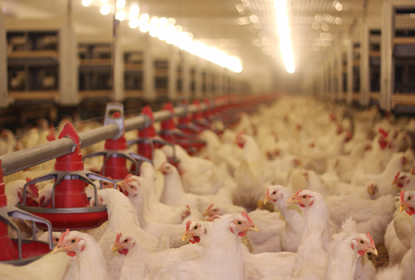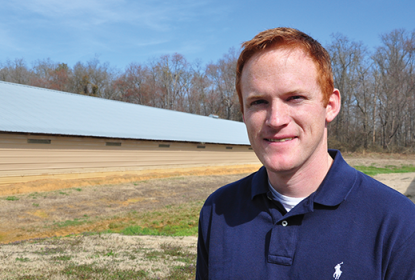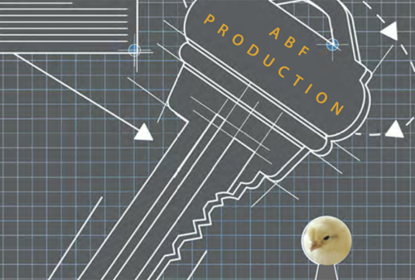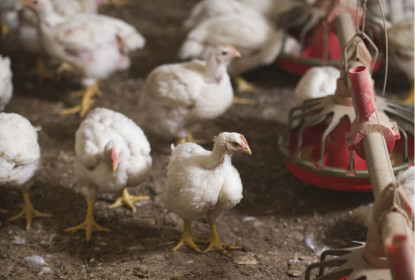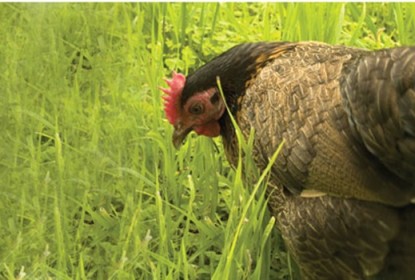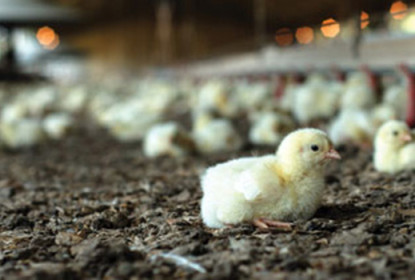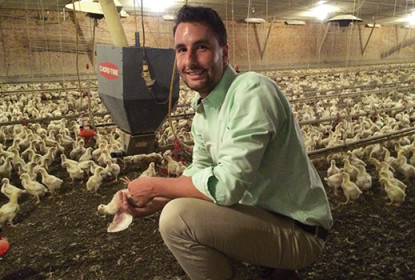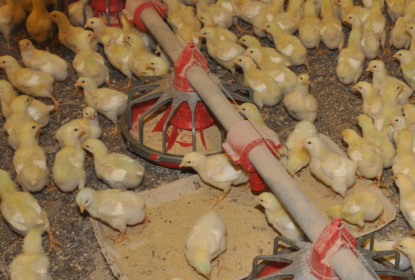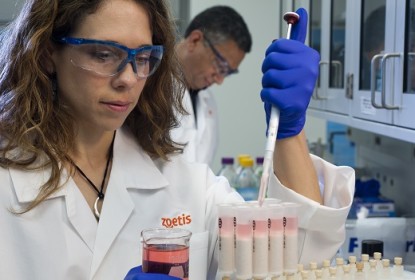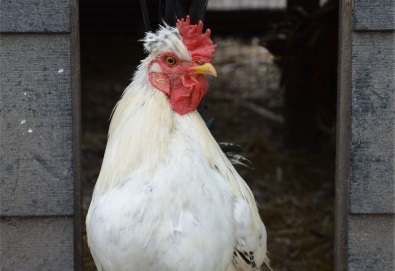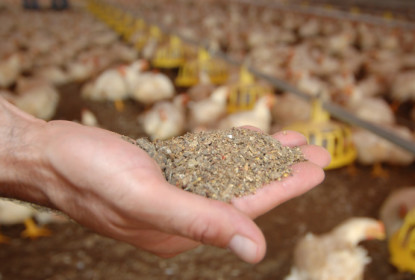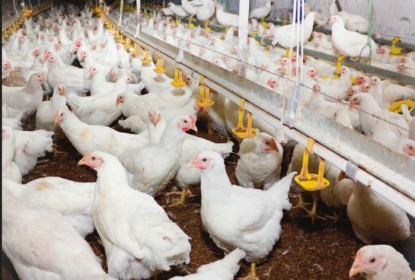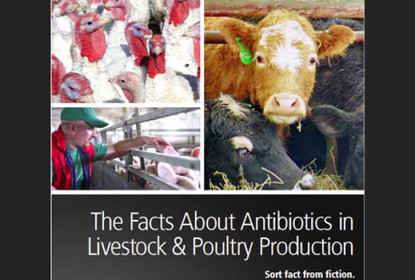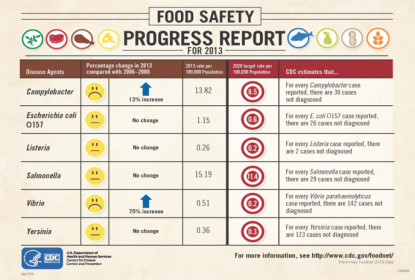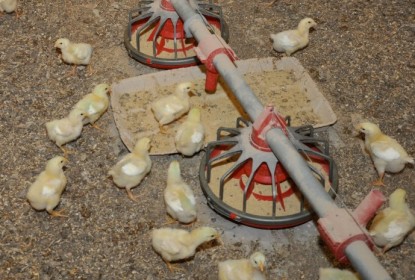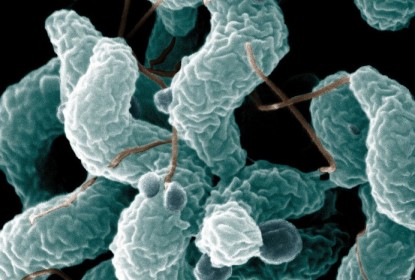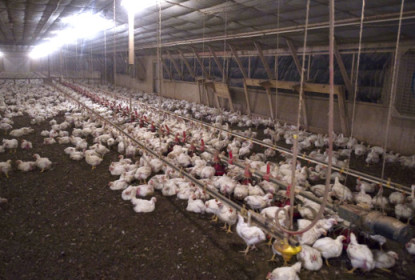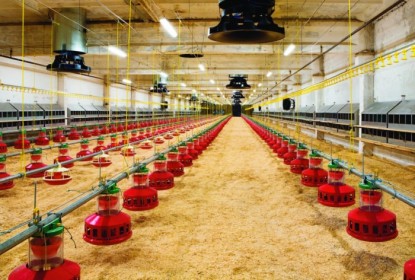Category Archive: Global TOPICS, Gut Health, News, PHT GLOBAL
... Fresh approach to coccidiosis needed to tackle increase in broiler gut damage
Nov 28, 2018Jennifer GrullonComments Off on Fresh approach to coccidiosis needed to tackle increase in broiler gut damage
Changes in the behavior of one of the most important coccidial pathogens means poultry producers should take a fresh look at how they deal with the parasite.... IBV vaccination protects broilers despite ammonia exposure
Nov 19, 2018Jennifer GrullonComments Off on IBV vaccination protects broilers despite ammonia exposure
A recent study corroborates previous findings that broilers properly vaccinated for infectious bronchitis virus (IBV) are protected from IBV challenge despite exposure to moderate levels of ammonia.... Heat stress may impair immune system in broilers
Nov 08, 2018Jennifer GrullonComments Off on Heat stress may impair immune system in broilers
Heat stress in broilers induced lesions of lymphoid tissues, indicating immune system impairment, but it’s not yet known if heat stress affects the vulnerability or severity of coccidiosis.
Diagnostics, Global TOPICS, Interviews, News, PHT GLOBAL, PHT US, Podcast, Respiratory, TOPICS, Videos
... Consistency, follow-up key to controlling IBV
Nov 05, 2018Jennifer GrullonComments Off on Consistency, follow-up key to controlling IBV
Infectious bronchitis virus (IBV) is a “moving target” and trying to keep ahead of it requires consistency and follow-up, explained Sjaak de Wit, DVM, PhD, of GD Animal Health, the Netherlands.
Biosecurity, Global TOP NEWS, Infectious Diseases, Interviews, News, PHT GLOBAL, PHT US, Podcast, Respiratory, TOP NEWS, Videos
... Biosecurity, disinfection, downtime keys to better ILT control
Nov 01, 2018Jennifer GrullonComments Off on Biosecurity, disinfection, downtime keys to better ILT control
Strict biosecurity is the best defense against infectious laryngotracheitis (ILT) in broiler flocks, advises Maricarmen García, PhD, a professor at the University of Georgia.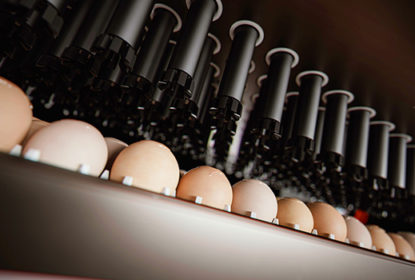
Global TOP NEWS, Hatchery, Infectious Diseases, Interviews, News, PHT GLOBAL, PHT US, Podcast, TOP NEWS, Videos
... Halting in ovo vaccination not a good option for managing hatchery bacteria
Oct 22, 2018Jennifer GrullonComments Off on Halting in ovo vaccination not a good option for managing hatchery bacteria
Higher 7-day mortality from bacterial infections in the hatchery is no reason to stop in ovo vaccination for Marek’s and other diseases, according to a consulting poultry veterinarian.... Vaccination protects broilers from IBV despite exposure to moderate ammonia levels
Oct 21, 2018Jennifer GrullonComments Off on Vaccination protects broilers from IBV despite exposure to moderate ammonia levels
Properly vaccinated commercial broilers are protected from an infectious bronchitis virus (IBV) challenge despite exposure to moderate ammonia levels, according to a study that surprised researchers.... AAAP issues call for papers for 2019 conference
Oct 18, 2018Jennifer GrullonComments Off on AAAP issues call for papers for 2019 conference
The American Association of Avian Pathologists (AAAP) is now accepting abstract submissions for its 2019 conference, Aug. 2-6, Washington, DC. The deadline is Dec. 3, 2018.... Three research-proven ways to maximize Marek’s disease control
Oct 07, 2018Jennifer GrullonComments Off on Three research-proven ways to maximize Marek’s disease control
By Tarsicio Villalobos, DVM, Zoetis... Study shows how unchanged boots disrupt biosecurity
Sep 26, 2018Jennifer GrullonComments Off on Study shows how unchanged boots disrupt biosecurity
Poultry farmers looking for ways to reduce the spread of viruses and bacteria in their facilities need look no further than the boots on their feet.... Modified-live vaccination reduced salmonellosis in Brazilian study
Sep 20, 2018Jennifer GrullonComments Off on Modified-live vaccination reduced salmonellosis in Brazilian study
New research confirms that modified-live vaccines (MLVs) can effectively reduce salmonellosis in broilers — a leading cause of food poisoning in humans.... Controlling coccidiosis helps prevent histomoniasis in broiler pullets
Sep 04, 2018Jennifer GrullonComments Off on Controlling coccidiosis helps prevent histomoniasis in broiler pullets
The incidence of histomoniasis, commonly known as blackhead disease, is increasing in Southeastern US broiler-breeding operations — and young breeders 25 to 30 weeks old seem particularly...... Blackhead disease causes reduced egg production in layer hens
Aug 03, 2018Jennifer GrullonComments Off on Blackhead disease causes reduced egg production in layer hens
Blackhead disease can cause an important drop in egg production among commercial layer hens, Christina Sigmon of North Carolina State University, said during the 2018 International Poultry Scientific...... Specialists share tips for optimizing immunity in ‘no antibiotics ever’ and ‘reduced use’ broiler flocks
Jul 14, 2018Jennifer GrullonComments Off on Specialists share tips for optimizing immunity in ‘no antibiotics ever’ and ‘reduced use’ broiler flocks
Finding ways to optimize immunity and give broilers more “staying power” could be the best strategy for maintaining the health and welfare of broilers, according to disease specialists at a...... Special Report: Nixing necrotic enteritis in broilers
Jul 09, 2018Jennifer GrullonComments Off on Special Report: Nixing necrotic enteritis in broilers
This week poultry specialists will gather in Denver, Colorado, for the second International Conference on Necrotic Enteritis. In this special report, Poultry Health Today looks at the impact of this...... Vaccination followed with feed medication gives pullets added protection against coccidiosis
Jul 02, 2018Jennifer GrullonComments Off on Vaccination followed with feed medication gives pullets added protection against coccidiosis
Inadequate coccidiosis protection in pullets can lead to health issues ranging from uneven weight gain to mortality.... More amino acids, feed aid broiler chicks vaccinated for coccidiosis
Jun 19, 2018Jennifer GrullonComments Off on More amino acids, feed aid broiler chicks vaccinated for coccidiosis
Feeding broilers a diet high in amino acids, along with more feed, can minimize the adverse effects on performance that sometimes occur after coccidiosis vaccination.... PROHEALTH to Present Sustainable Solutions for Broiler Health at VIV Europe 2018
Jun 18, 2018Jennifer GrullonComments Off on PROHEALTH to Present Sustainable Solutions for Broiler Health at VIV Europe 2018
Smart ideas for sustainable poultry disease management will be featured in a special PROHEALTH workshop at VIV Europe 2018, to be held June 20-22 in Utrecht, Netherlands.... Loose stools linked to blackhead disease transmission in turkeys
May 17, 2018Jennifer GrullonComments Off on Loose stools linked to blackhead disease transmission in turkeys
Enteric inflammation and loose stools can affect the rate that turkeys contract blackhead disease.... Tyson vet: Act quickly on unexplained poultry mortality
May 01, 2018Jennifer GrullonComments Off on Tyson vet: Act quickly on unexplained poultry mortality
Quick action by breeder managers and veterinarians is credited with the rapid resolution of an avian influenza (AI) outbreak in Tennessee in March of 2017.... Rennier: NAE programs represented 40% of US broiler feeds in 2017
Apr 30, 2018Jennifer GrullonComments Off on Rennier: NAE programs represented 40% of US broiler feeds in 2017
Chickens raised without antibiotics of any type consumed 40% of the broiler feed produced un the US in 2017, according to Greg Rennier, PhD, president of Rennier Associates Inc.... USDA, industry groups take issue with WHO’s statement on poultry antibiotics
Apr 13, 2018Jennifer GrullonComments Off on USDA, industry groups take issue with WHO’s statement on poultry antibiotics
The USDA’s chief scientist and several scientific and industry organizations took issue with the World Health Organization’s recent news release recommending that poultry and livestock producers...... Lack of medications, veterinarians hamper turkey industry
Apr 10, 2018Jennifer GrullonComments Off on Lack of medications, veterinarians hamper turkey industry
The US turkey industry continues to be hampered by a lack of approved efficacious drugs, according to a 2017 survey. Since 2005, four medications have been withdrawn, leaving the industry without any...... Layer-hen stocking density affects Salmonella shedding
Mar 15, 2018Jennifer GrullonComments Off on Layer-hen stocking density affects Salmonella shedding
Lower stocking density for laying hens was associated with less fecal shedding of Salmonella Heidelberg in a USDA study.... Can improper vaccination make IBV worse?
Feb 23, 2018Jennifer GrullonComments Off on Can improper vaccination make IBV worse?
Improper vaccination not only fails to protect flocks from infectious bronchitis virus (IBV), but it can also make the problem worse, a leading poultry health expert says.... E. coli vaccination reduces antibiotic use in broilers
Feb 12, 2018Jennifer GrullonComments Off on E. coli vaccination reduces antibiotic use in broilers
New studies showed that vaccination against Escherichia coli significantly reduced antibiotic use on commercial broiler farms, particularly in birds at high risk of infection.... Poultry Health Today lines up video interviews with leading poultry experts at IPPE
Jan 29, 2018Jennifer GrullonComments Off on Poultry Health Today lines up video interviews with leading poultry experts at IPPE
More than two dozen poultry-health experts and trend watchers will be interviewed on camera over the next three days as part of Poultry Health Today’s news coverage of the 2018 International...... More poultry research focusing on antibiotic alternatives
Jan 26, 2018Jennifer GrullonComments Off on More poultry research focusing on antibiotic alternatives
The poultry industry’s focus on alternative approaches to managing gut health should help preserve the efficacy of the few remaining antibiotics it has available, said Donna Carver, DVM, PhD.... Planning anticoccidial rotation strategies: Consider the consequences
Jan 25, 2018Jennifer GrullonComments Off on Planning anticoccidial rotation strategies: Consider the consequences
Anticoccidial rotation strategies help reduce the health and economic impact of coccidiosis, while preserving the efficacy of the limited range of tools available for managing it.... Deadly duo: Study shows link between E. maxima, Clostridium
Dec 12, 2017Jennifer GrullonComments Off on Deadly duo: Study shows link between E. maxima, Clostridium
New research by Callie McQuain, DVM, veterinarian and grad student at the University of Georgia, substantiates anecdotal field experience indicating that Eimeria maxima is the type of coccidia that...... Avian influenza viruses can persist in footbaths and manure
Dec 08, 2017Jennifer GrullonComments Off on Avian influenza viruses can persist in footbaths and manure
Growers shouldn’t assume the disinfectants they use in footbaths are effective against avian influenza (AI), indicates a study from the University of California–Davis.... Is incentivized vaccination the answer to poultry’s public-health woes?
Dec 07, 2017Jennifer GrullonComments Off on Is incentivized vaccination the answer to poultry’s public-health woes?
Governments and retailers should incentivize broiler producers to make better use of vaccines that could help protect public health, according to an expert in poultry infections.... Check farm biosecurity now ahead of potential avian flu return, disease expert says
Dec 07, 2017Jennifer GrullonComments Off on Check farm biosecurity now ahead of potential avian flu return, disease expert says
Poultry producers should assess their farm biosecurity in preparation for a return of avian influenza this winter, according to an expert in the spread and control on animal disease.... 44 million ‘respectable’ birds on the menu this Thanksgiving
Nov 20, 2017Jennifer GrullonComments Off on 44 million ‘respectable’ birds on the menu this Thanksgiving
If one of America’s founding fathers, Benjamin Franklin, had his way in the late 1700s, the turkey would have been the US national bird instead of the bald eagle — a majestic but imposing raptor...... Salmonella on carcass skin can contaminate ground turkey
Nov 06, 2017Jennifer GrullonComments Off on Salmonella on carcass skin can contaminate ground turkey
Salmonella on the skin, rather than in infected muscle tissue, may be a significant contributor to ground-turkey contamination, indicates a study presented at the 2017 annual meeting of the American...... New Marek’s test helps ensure successful vaccination, biosecurity
Oct 23, 2017Jennifer GrullonComments Off on New Marek’s test helps ensure successful vaccination, biosecurity
A new test is helping producers in Europe better protect their flocks against Marek’s disease (MD).... E. maxima linked to mortality in broilers vaccinated for coccidiosis
Oct 17, 2017Jennifer GrullonComments Off on E. maxima linked to mortality in broilers vaccinated for coccidiosis
Eimeria maxima in broilers vaccinated against coccidiosis appears to be an important cause of mortality, according to the preliminary results of a study presented at the 2017 annual meeting of the...... Understanding the clinical picture key to effective IB control
Oct 13, 2017Jennifer GrullonComments Off on Understanding the clinical picture key to effective IB control
Avian infectious bronchitis virus (IBV) is a highly contagious coronavirus found in chickens worldwide that costs the US poultry industry millions of dollars annually.... Three-pronged E. coli strategy to help cut losses, improve profitability
Oct 11, 2017Jennifer GrullonComments Off on Three-pronged E. coli strategy to help cut losses, improve profitability
Managing Escherichia coli infection in commercial poultry flocks has to be tackled on three fronts to help cut losses and improve profitability, says Allan Ball, of the Slate Hall Veterinary Practice...... New flock-management trends call for new E. coli-management strategies, vets say
Oct 10, 2017Jennifer GrullonComments Off on New flock-management trends call for new E. coli-management strategies, vets say
Two poultry veterinarians say that prevention of Escherichia coli infection is key as management trends toward free-range housing and reduced antibiotic use.... Proper windrowing can minimize disease, benefit environmental management
Oct 01, 2017Jennifer GrullonComments Off on Proper windrowing can minimize disease, benefit environmental management
By George W. Malone, MS Malone Poultry Consulting Princess Anne, Maryland... Successful ABF production: Mastered technique or corporate culture?
Sep 29, 2017Jennifer GrullonComments Off on Successful ABF production: Mastered technique or corporate culture?
Indiana's Miller Poultry's owner and president Galen Miller and production manager Stephen Shepard discuss their experiences, priorities, management style and business philosophy that led to 30%...... Hofacre: There’s always room for improvement with Salmonella
Sep 21, 2017Jennifer GrullonComments Off on Hofacre: There’s always room for improvement with Salmonella
Most US poultry companies are doing an “outstanding job” controlling Salmonella, but there's always room for improvement.... Livestock farming standards to get boost under antimicrobial-resistance plan
Sep 17, 2017Jennifer GrullonComments Off on Livestock farming standards to get boost under antimicrobial-resistance plan
The European Commission has unveiled plans to promote better global livestock farming standards in a bid to combat the growing threat of antimicrobial resistance (AMR) in animals and humans.... Superbug warning over India’s poultry antibiotics use
Sep 05, 2017Jennifer GrullonComments Off on Superbug warning over India’s poultry antibiotics use
The use of antibiotics for growth promotion in Indian poultry production is helping to breed bacteria that are highly resistant to most antibiotics, scientists have warned.... US flocks have room to improve in avian flu protection
Sep 05, 2017Jennifer GrullonComments Off on US flocks have room to improve in avian flu protection
The US poultry sector can still do more to protect flocks from avian influenza, despite making significant efforts to improve biosecurity since the last major outbreak of the disease.... UK makes significant cuts in poultry antibiotic use
Sep 05, 2017Jennifer GrullonComments Off on UK makes significant cuts in poultry antibiotic use
The UK poultry sector has reduced its antibiotic use by more than 70% over four years, according to latest industry figures.... Coccidiosis, necrotic enteritis challenge cage-free layer systems
Aug 30, 2017Jennifer GrullonComments Off on Coccidiosis, necrotic enteritis challenge cage-free layer systems
Cage-free housing for egg layers allows birds to exhibit more natural behaviors, but it also carries an increased risk for morbidity and mortality...... Compartmentalization key to global avian flu control
Aug 30, 2017Jennifer GrullonComments Off on Compartmentalization key to global avian flu control
Standardizing biosecurity measures across the poultry sector is key to protecting birds from avian influenza and ensuring outbreaks do not decimate trade, according to a poultry health expert.... Sanderson Farms targets ‘marketing gimmicks’ about antibiotics
Aug 04, 2017Jennifer GrullonComments Off on Sanderson Farms targets ‘marketing gimmicks’ about antibiotics
A new ad campaign released by Sanderson Farms Inc. seeks to debunk myths surrounding the use of antibiotics in US poultry production while exposing what it calls “marketing gimmicks designed to...... Reducing food-borne bacterial infections must be team effort
Jul 25, 2017Jennifer GrullonComments Off on Reducing food-borne bacterial infections must be team effort
Increased pressure to reduce bacterial food-borne infections in consumers is affecting poultry production from start to finish, panelists reported at a food safety roundtable, “Lightening the Load:...... Poultry veterinarian named to AVMA Future Leaders program
Jul 23, 2017Jennifer GrullonComments Off on Poultry veterinarian named to AVMA Future Leaders program
Tak Niino, VMD, a senior poultry technical services representative for Zoetis, was one of 10 veterinarians in different fields selected to the Future Leaders program of the American Veterinary...... Breeder E. coli vaccination boosts broiler health
Jul 06, 2017Jennifer GrullonComments Off on Breeder E. coli vaccination boosts broiler health
Vaccination of broiler breeders against Escherichia coli helps improve the health of their progeny, reports a veterinarian in South Africa.... Striking a balance with ABF poultry production
Jun 24, 2017Jennifer GrullonComments Off on Striking a balance with ABF poultry production
Back in 2013, less than 5% of the chicken produced in the US was raised without antibiotics. That number could reach 25% to 30% within 5 years. How is the poultry industry adjusting?... Lapses in biosecurity: Veterinarian urges poultry companies to avoid these mistakes
Jun 19, 2017Jennifer GrullonComments Off on Lapses in biosecurity: Veterinarian urges poultry companies to avoid these mistakes
Biosecurity needs to be approached as a comprehensive process, not as a series of segregated actions, according to Jean Sander, DVM, senior technical services veterinarian for Zoetis.... Air quality affects S. Heidelberg colonization in broilers
Jun 15, 2017Jennifer GrullonComments Off on Air quality affects S. Heidelberg colonization in broilers
Improving air quality in broiler houses may be an important way to reduce colonization of S. Heidelberg, according to the results of a study presented at the 2017 International Poultry Scientific...... Options for Salmonella control in live poultry production
Jun 15, 2017Jennifer GrullonComments Off on Options for Salmonella control in live poultry production
By Steven C. Ricke, PhD Professor, University of Arkansas Director, Center for Food Safety, Institute of Food Science and Engineering University of Arkansas... Poultry Health Today unveils new tools for saving content, creating custom reports
Jun 06, 2017Jennifer GrullonComments Off on Poultry Health Today unveils new tools for saving content, creating custom reports
Poultry Health Today — the industry’s only news website focused on flock health and welfare — has added new tools that allow registered users to bookmark favorites, save items for later viewing...... Both organic, conventional processing reduce Campylobacter on carcasses
May 03, 2017Jennifer GrullonComments Off on Both organic, conventional processing reduce Campylobacter on carcasses
Both conventional and organic processing methods reduced Campylobacter on broiler carcasses in a recent study by Purdue University. Matthew Bailey, a grad student at the university, discussed the...... IBDV: Management obstacles and options
Apr 26, 2017Jennifer GrullonComments Off on IBDV: Management obstacles and options
By Daral J. Jackwood, PhD Professor, Department of Veterinary Preventive Medicine Food Animal Health Research Program Ohio Agricultural Research and Development Center The Ohio State University... Shortage of medications remains top issue for US turkey industry
Apr 24, 2017Jennifer GrullonComments Off on Shortage of medications remains top issue for US turkey industry
A shortage of effective, FDA-approved medications is still the top health issue for the US turkey industry, according to a survey conducted by a turkey veterinarian.... Antibiotic issues broaden poultry veterinarians’ role
Apr 18, 2017Jennifer GrullonComments Off on Antibiotic issues broaden poultry veterinarians’ role
By Philip A. Stayer, DVM, MS, ACPV Corporate Veterinarian Sanderson Farms, Inc.... ‘Old bug’ with new name easily mistaken for E. coli peritonitis
Apr 12, 2017Jennifer GrullonComments Off on ‘Old bug’ with new name easily mistaken for E. coli peritonitis
Commercial chicken flocks that appear to have Escherichia coli peritonitis might actually be infected with a re-emerging old pathogen with a new name.... Vaccination helping to reduce mortality rates from E. coli in France’s layer flocks
Apr 04, 2017Jennifer GrullonComments Off on Vaccination helping to reduce mortality rates from E. coli in France’s layer flocks
Four out of five health problems in layer flocks in France are related to Escherichia coli, according to Jocelyn Marguerie, DVM.... Better accuracy, hatchability, protection seen in birds vaccinated with dual-needle system
Mar 27, 2017Jennifer GrullonComments Off on Better accuracy, hatchability, protection seen in birds vaccinated with dual-needle system
Broiler studies demonstrate that a dual-needle in ovo delivery system yields more accurate vaccine placement, better hatchability and better disease protection compared to a single-needle...... 5 ABF health tips from Miller Poultry
Mar 08, 2017Jennifer GrullonComments Off on 5 ABF health tips from Miller Poultry
Miller Poultry — an Indiana-based producer with more than 15 years' experience raising broilers without antibiotics — offers tips for ensuring a strong, healthy and efficient bird.
Infectious Diseases, ippe2016- Interviews with experts, News, PHT US, Respiratory, TOPICS, Uncategorized, Videos
... Avian influenza in the US: High-path, low-path and its link to other poultry diseases
Mar 07, 2017Jennifer GrullonComments Off on Avian influenza in the US: High-path, low-path and its link to other poultry diseases
David Swayne, DVM, PhD, a research veterinarian at USDA with more than 30 years' experience with avian influenza, talks to Poultry Health Today about the dreaded virus — how it travels, the...... New lasalocid MRLs relieve export restrictions for broilers
Feb 15, 2017Jennifer GrullonComments Off on New lasalocid MRLs relieve export restrictions for broilers
Broiler producers who want more diversity in their anticoccidial-rotation plan can now consider the ionophore lasalocid without worrying about it putting a damper on exports, says Jon Schaeffer, DVM,...... Windrowing litter can reduce pressure from poultry viruses, insects and bacteria
Feb 05, 2017Jennifer GrullonComments Off on Windrowing litter can reduce pressure from poultry viruses, insects and bacteria
Poultry producers looking to improve litter quality and flock health should consider windrowing — a practice that not only works to control ammonia in the reconditioned litter but also reduces...... Inexperience leads to disaster in small specialty poultry flock
Feb 03, 2017Jennifer GrullonComments Off on Inexperience leads to disaster in small specialty poultry flock
Disease and high mortality in a small Midwestern poultry operation demonstrate the consequences of inexperience coupled with the treatment restraints of organic farming, Patricia Wakenell, DVM, PhD,...... Surveillance, careful vaccine selection tops “shoot-in-the-dark” strategy for IB control
Feb 02, 2017Jennifer GrullonComments Off on Surveillance, careful vaccine selection tops “shoot-in-the-dark” strategy for IB control
Microbiologist Mark Jackwood, PhD, University of Georgia, urges producers not to “shoot in the dark” with infectious bronchitis vaccines and, instead, to focus on surveillance, monitoring and...... Accessibility is key when storing VFDs at integrated companies
Jan 31, 2017Jennifer GrullonComments Off on Accessibility is key when storing VFDs at integrated companies
The best place for integrated companies to store veterinary feed directives (VFDs) should depend on whether they’re keeping hard or electronic copies.... Cage-free hen housing: How far will the pendulum swing?
Jan 28, 2017Jennifer GrullonComments Off on Cage-free hen housing: How far will the pendulum swing?
By John Brown, DVM Senior Technical Services Veterinarian, Zoetis... Poultry Health Today lines up video interviews with more than 30 poultry experts at IPPE
Jan 26, 2017Jennifer GrullonComments Off on Poultry Health Today lines up video interviews with more than 30 poultry experts at IPPE
More than 30 poultry-health experts and trend watchers will be interviewed on camera over the next three days as part of Poultry Health Today’s news coverage of the 2017 International Production...... Interpreting the language of the new VFD rule
Jan 25, 2017Jennifer GrullonComments Off on Interpreting the language of the new VFD rule
In a candid 90-minute interview, William Flynn, DVM, MS, deputy director for science and policy for FDA’s Center for Veterinary Medicine, clarified some hazy points of the new veterinary feed...... Exploring the cause of condemnations can reduce losses
Jan 25, 2017Jennifer GrullonComments Off on Exploring the cause of condemnations can reduce losses
When carcasses are rejected at processing, all the time and money that went into production is lost. Couple that with even slight increases in the condemnation rate, and the losses really mount.... Research: Highly pathogenic AI does not persist in wild birds
Jan 25, 2017Jennifer GrullonComments Off on Research: Highly pathogenic AI does not persist in wild birds
While the H5 avian influenza A virus that devastated some Midwestern poultry farms in 2014 to 2015 was initially spread by migratory waterfowl, evidence now suggests that highly pathogenic flu...... Early SE infection likely to stay with broilers until market age
Jan 25, 2017Jennifer GrullonComments Off on Early SE infection likely to stay with broilers until market age
Broilers with lung exposure to Salmonella Enteritidis (SE) on the day of hatch are very likely to be positive for the pathogen at market age, say investigators.... E. coli infection: Two types in broilers
Jan 25, 2017Jennifer GrullonComments Off on E. coli infection: Two types in broilers
While infectious bronchitis virus (IBV) remains a serious threat to broiler health, it often opens the door to costlier secondary E. coli infection.... Early feeding, housing may affect broiler response to immune challenges
Jan 25, 2017Jennifer GrullonComments Off on Early feeding, housing may affect broiler response to immune challenges
Early feeding after hatch and the housing type can affect the response of broilers to immune challenges later in life, indicates a study from the Netherlands.... Fast growth seen for ABF poultry production, but for how long?
Jan 24, 2017Jennifer GrullonComments Off on Fast growth seen for ABF poultry production, but for how long?
To see how the antibiotic-free (ABF) production trend is playing out with producers’ plans, Poultry Health Today turned to Greg Rennier, PhD, a poultry-market research specialist who tracks product...... View from Europe on ABF
Jan 24, 2017Jennifer GrullonComments Off on View from Europe on ABF
Striving for responsible antibiotic use may be a better strategy than going 100% antibiotic-free, according to a gut-disease specialist.... NCC to food industry and consumers: Go slow on slower-growing chickens
Jan 12, 2017Jennifer GrullonComments Off on NCC to food industry and consumers: Go slow on slower-growing chickens
The National Chicken Council is urging food-service and retail industries, non-governmental organizations and consumers to go slow on the slow-growth chicken trend before evaluating its potential...... Plant inspectors help poultry industry monitor welfare
Jan 05, 2017Jennifer GrullonComments Off on Plant inspectors help poultry industry monitor welfare
Processors understand that the humane treatment of chickens during processing is simply the right thing to do. It also is the law.... Understanding lasalocid: Veterinarian offers tips for getting the most from this proven anticoccidial
Jan 02, 2017Jennifer GrullonComments Off on Understanding lasalocid: Veterinarian offers tips for getting the most from this proven anticoccidial
Developing a long-term strategy for managing coccidiosis in broilers is more critical today than ever before — not just to preserve the efficacy of our remaining medications, but also to keep...... Poultry companies need to balance consumer preferences with flock health, welfare and food safety
Dec 19, 2016Jennifer GrullonComments Off on Poultry companies need to balance consumer preferences with flock health, welfare and food safety
Suzanne Dougherty, DVM, a consulting poultry veterinarian based in Alabama, talks with Poultry Health Today about the challenges of reducing or even eliminating antibiotics in broiler production...... NCC scientist: Food safety is everyone’s job
Dec 15, 2016Jennifer GrullonComments Off on NCC scientist: Food safety is everyone’s job
Food safety is a chain stretching from producers to consumers. Ashley Peterson, PhD, of the National Chicken Council, shared her insights at the recent “Young Chicken Gross Pathology Workshop” at...... Addressing consumers’ misconceptions about antibiotic use in poultry
Dec 15, 2016Jennifer GrullonComments Off on Addressing consumers’ misconceptions about antibiotic use in poultry
Gary Thornton, editor of Poultry USA, talks about the importance and the challenges of communicating with consumers about the role of antibiotics in poultry production.... Video provides practical biosecurity tips for poultry
Nov 12, 2016Jennifer GrullonComments Off on Video provides practical biosecurity tips for poultry
A training video that provides practical biosecurity tips for protecting commercial poultry flocks from avian influenza and other infectious diseases has been developed by the University of Maryland...... Are there practical alternatives to ionophores?
Nov 05, 2016Jennifer GrullonComments Off on Are there practical alternatives to ionophores?
Proponents of raising broilers without ionophores and other antibiotics have proposed putting more emphasis on farm management, biosecurity and alternatives to anticoccidials.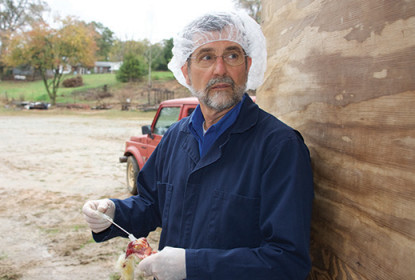
Antibiotic-free, Flock welfare, Gut Health, Infectious Diseases, ippe2016 - Highlights from our latest issue, News, PHT GLOBAL, PHT US
... The Poultry Smith
Nov 02, 2016Jennifer GrullonComments Off on The Poultry Smith
In this exclusive interview with Poultry Health Today, Fieldale Farms veterinarian John Smith reflects on his career, the state of the US poultry industry and, most importantly, what it needs to do...... Backyard flocks biggest risk for spreading vvIBDV in US
Oct 17, 2016Jennifer GrullonComments Off on Backyard flocks biggest risk for spreading vvIBDV in US
By Daral J. Jackwood, PhD Professor, Department of Veterinary Preventive Medicine Food Animal Health Research Program Ohio Agricultural Research and Development Center The Ohio State University... Biosecurity in poultry production: What makes it work — and what doesn’t
Oct 09, 2016Jennifer GrullonComments Off on Biosecurity in poultry production: What makes it work — and what doesn’t
By Jean-Pierre Vaillancourt, DMV, MSc, PhD Professor, director Research Group on the Epidemiology of Zoonoses and Public Health Faculté de Médecine Vétérinaire Associate director Université...... FDA: Some antibiotics still OK for production purposes
Oct 05, 2016Jennifer GrullonComments Off on FDA: Some antibiotics still OK for production purposes
New FDA guidelines that discourage using medically important antibiotics for promoting growth in food animals appear to have been well-received by both producers and most consumer activists. Change...... Condemnations, mortality shift focus to E. coli vaccination in some broiler flocks
Sep 16, 2016Jennifer GrullonComments Off on Condemnations, mortality shift focus to E. coli vaccination in some broiler flocks
While infectious bronchitis remains a serious threat to broiler health, it often opens the door to the more costly secondary infection, E coli, explained Kalen Cookson, DVM, director of clinical...... Anticoccidial rotation, good husbandry can improve coccidiosis control
Aug 16, 2016Jennifer GrullonComments Off on Anticoccidial rotation, good husbandry can improve coccidiosis control
Poultry producers worldwide know the importance of cutting losses from coccidiosis – the parasitic disease that is still causing significant losses in growth rate and feed efficiency.... Hens in enriched colony system appear more stressed, flighty
Aug 05, 2016Jennifer GrullonComments Off on Hens in enriched colony system appear more stressed, flighty
Hens in an enriched colony system were more stressed and flighty than conventionally caged birds in a study from Mississippi State and Texas A&M Universities.... Managing ionophores and diets for best performance
Jul 31, 2016Jennifer GrullonComments Off on Managing ionophores and diets for best performance
Carla Price, PhD, a consulting poultry nutritionist based in Mississippi, says that for best results, producers need to consider differences in ionophores when formulating poultry feeds.... S. enteritidis shedding more frequent among hens in conventional cages
Jul 24, 2016Jennifer GrullonComments Off on S. enteritidis shedding more frequent among hens in conventional cages
Fecal shedding of Salmonella enteritidis was significantly more frequent among experimentally infected laying hens in conventional cages compared to hens housed in enriched colony cages, indicates a...... Integrated poultry companies can store VFDs in one place
Jul 15, 2016Jennifer GrullonComments Off on Integrated poultry companies can store VFDs in one place
Integrated poultry companies that obtain a veterinary feed directive from a staff veterinarian for use in company-owned feed mills and flocks can store the VFD forms in one place.... Broiler study shows challenges and potential of drug-free production
Jul 08, 2016Jennifer GrullonComments Off on Broiler study shows challenges and potential of drug-free production
Broilers raised in a drug-free program had a higher feed-conversion ratio (FCR), decreased mean daily weight and decreased mean live marketing weight despite administration of antibiotic
Antibiotic-free, Global TOP NEWS, Gut Health, ippe2016- Interviews with experts, News, PHT GLOBAL, PHT US, TOP NEWS, Videos
... Mathis: Long-term planning key to effective coccidiosis management
Jul 07, 2016Jennifer GrullonComments Off on Mathis: Long-term planning key to effective coccidiosis management
Whether the production system is antibiotic-free or conventional, long-term planning and strategic rotation programs are the best ways to ensure effective, sustainable control of coccidiosis, the...... Four tips for taking the lead on the animal-welfare conversation
Jul 03, 2016Jennifer GrullonComments Off on Four tips for taking the lead on the animal-welfare conversation
By Carla Price, PhD CJP Nutrition Ellisville, Miss.... Talking with customers about antibiotic use and other poultry-production practices
Jun 14, 2016Jennifer GrullonComments Off on Talking with customers about antibiotic use and other poultry-production practices
Today’s consumers face a bewildering array of labels and marketing claims when purchasing poultry products — particularly as it relates to antibiotics.... Successful Marek’s disease vaccination: The devil is in the details
Jun 14, 2016Jennifer GrullonComments Off on Successful Marek’s disease vaccination: The devil is in the details
By Don Ritter, DVM, ACPV Senior Director of Health Services and Food Safety Mountaire Farms Inc.... Bill Gates leading drive to buy chicken flocks for impoverished families
Jun 14, 2016Jennifer GrullonComments Off on Bill Gates leading drive to buy chicken flocks for impoverished families
If you were living on $2 a day, what would you do to improve your life? If you’re Bill Gates, you'd raise chickens.... Tyson vet shares experiences with antibiotic-free broilers
Jun 02, 2016Jennifer GrullonComments Off on Tyson vet shares experiences with antibiotic-free broilers
Producing Salmonella-free chicks without antibiotics is a delicate procedure — sort of a little like baking a cake, says Scott Gustin, DVM, director of veterinary services for Tyson.... New FDA guidelines: Rating an animal antibiotic’s importance to humans
May 25, 2016Jennifer GrullonComments Off on New FDA guidelines: Rating an animal antibiotic’s importance to humans
The new industry guidelines issued by the US Food and Drug Administration in December suggest removing performance claims from food-animal antimicrobials deemed “medically important” to humans...... Water pressure: How does it affect broilers’ consumption, performance?
May 23, 2016Jennifer GrullonComments Off on Water pressure: How does it affect broilers’ consumption, performance?
Low-pressure water systems designed to reduce water usage have some poultry growers turning up the pressure to hydrate flocks and improve bird performance, but is this a sound practice economically?... Five opportunities to optimize gut health, minimize necrotic enteritis in broilers
May 16, 2016Jennifer GrullonComments Off on Five opportunities to optimize gut health, minimize necrotic enteritis in broilers
By Suzanne Dougherty, DVM, MAM, MS, DACPV Pecking Around Consulting, Inc. Madison, Ala.... Still confused about VFDs? Panel brings clarity to new rules
May 11, 2016Jennifer GrullonComments Off on Still confused about VFDs? Panel brings clarity to new rules
More than 1,000 representatives from the US poultry and livestock industries attended a recent webinar to get a better handle on the FDA’s new rules for the Veterinary Feed Directive (VFD).... IBD vaccination: HVT vector vaccine or live?
May 10, 2016Jennifer GrullonComments Off on IBD vaccination: HVT vector vaccine or live?
By Kalen Cookson, DVM, MAM Director of clinical research Zoetis Inc.... Judicious antibiotic use: What does it mean in poultry?
Apr 29, 2016Jennifer GrullonComments Off on Judicious antibiotic use: What does it mean in poultry?
By Dennis P. Wages, DVM, Dipl. ACPV Professor, Poultry Health Management Department of Population Health and Pathobiology College of Veterinary Medicine — North Carolina State University
Antibiotic-free, Global TOPICS, Gut Health, ippe2016- Interviews with experts, News, PHT GLOBAL, PHT US, Videos
... Alternative treatments for necrotic enteritis: Has CQR’s Steve Davis found the ‘silver bullet’?
Apr 29, 2016Jennifer GrullonComments Off on Alternative treatments for necrotic enteritis: Has CQR’s Steve Davis found the ‘silver bullet’?
For years Steve Davis, DVM, of Colorado Quality Research had been looking for what he calls the "silver bullet" for managing NE in broilers without antibiotics.... Editorial – Judicious antibiotic use: How should the poultry industry be judged?
Apr 27, 2016Jennifer GrullonComments Off on Editorial – Judicious antibiotic use: How should the poultry industry be judged?
Beginning in January 2017, FDA will require veterinarians to issue a veterinary feed directive, or VFD, for any medically important antibiotics administered through poultry or livestock feed.... Necrotic enteritis in broilers: Disease or syndrome?
Apr 26, 2016Jennifer GrullonComments Off on Necrotic enteritis in broilers: Disease or syndrome?
Steve Davis, DVM, of Colorado Quality Research, talks about emerging virulent strains of Clostridium perfringens and their impact on the prevalence severity of necrotic enteritis in broilers.... Field vaccination for respiratory disease: spray or pump?
Apr 14, 2016Jennifer GrullonComments Off on Field vaccination for respiratory disease: spray or pump?
By Philip A. Stayer, DVM Corporate Veterinarian Sanderson Farms, Inc.
Global TOP NEWS, Infectious Diseases, ippe2016 - Highlights from our latest issue, News, PHT GLOBAL, Research, Respiratory
... IBD V877 vaccine can break through maternal antibodies
Apr 10, 2016Jennifer GrullonComments Off on IBD V877 vaccine can break through maternal antibodies
A live infectious bursal disease (IBD) vaccine based on the V877 strain can override maternal antibodies, doesn’t revert to virulence and has limited interactions with other live vaccines.
Food Safety, Global TOP NEWS, ippe2016- Interviews with experts, News, PHT GLOBAL, PHT US, TOP NEWS, Videos
... Meeting the new USDA/FSIS standards for Salmonella and Campylobacter in poultry
Apr 10, 2016Jennifer GrullonComments Off on Meeting the new USDA/FSIS standards for Salmonella and Campylobacter in poultry
USDA/FSIS issued new standards for Salmonella and Campylobacter in ground poultry meat and chicken and turkey parts.... Mountaire veterinarian discusses managing E. coli in broilers in the face of IBV infection
Apr 07, 2016Jennifer GrullonComments Off on Mountaire veterinarian discusses managing E. coli in broilers in the face of IBV infection
Don Ritter, DVM, of Mountaire Farms, details the company’s recent bout with IB in broilers and the costly secondary infection of E. coli that followed.... Live E. coli, Salmonella vaccines remained effective when used together in challenge study
Apr 06, 2016Jennifer GrullonComments Off on Live E. coli, Salmonella vaccines remained effective when used together in challenge study
Administration of a modified-live Escherichia coli vaccine along with a live Salmonella vaccine does not appear to affect the efficacy of either, indicate the results of a recent challenge study.[1]...... Changes ahead: Everything you need to know about the new guidelines for oral antimicrobials
Apr 05, 2016Jennifer GrullonComments Off on Changes ahead: Everything you need to know about the new guidelines for oral antimicrobials
The US poultry industry has already shown that it knows how to use antimicrobials judiciously. In this special report, Poultry Health Today editors take an in-depth look at what FDA calls Guidance...... Randall Singer: Therapeutics and antibiotic resistance
Apr 03, 2016Jennifer GrullonComments Off on Randall Singer: Therapeutics and antibiotic resistance
By Randall S. Singer, DVM, MPVM, PhD Department of Veterinary and Biomedial Sciences University of Minnesota, St. Paul, MN... Study shows value of E. coli vaccine in chickens
Mar 30, 2016Jennifer GrullonComments Off on Study shows value of E. coli vaccine in chickens
A live Escherichia coli vaccine provided a high level of protection to chickens challenged with the same E. coli strain as well as cross-protection against a different strain in a recent study...
Announcements, Antibiotic-free, Flock welfare, Food Safety, Gut Health, Infectious Diseases, ippe2016 - Highlights from our latest issue, Mobile Only, News, PHT GLOBAL, PHT US
... Specialists explore new options for managing flock health while defending judicious antibiotic use
Mar 27, 2016Jennifer GrullonComments Off on Specialists explore new options for managing flock health while defending judicious antibiotic use
Growing demand for poultry raised without food-animal antibiotics has put more pressure on veterinarians to find alternative yet dependable disease-control options, according to a panel of nine...... Thinking about going antibiotic-free? Expert panel offers insights, suggestions
Mar 10, 2016Jennifer GrullonComments Off on Thinking about going antibiotic-free? Expert panel offers insights, suggestions
Broiler and turkey companies need to think carefully and weigh all the possible impacts before considering a move to antibiotic-free production, said poultry health experts at a panel discussion held...... Candid camera: Undercover videos on rise in poultry industry
Feb 03, 2016Jennifer GrullonComments Off on Candid camera: Undercover videos on rise in poultry industry
Undercover videos of poultry farms made by animal activists appear to be on the rise, Mark Crouser, a consultant to the Center for Food Integrity (CFI), reported at the recent National Meeting on...... Poultry Health Today launches mobile app
Jan 24, 2016Jennifer GrullonComments Off on Poultry Health Today launches mobile app
Poultry Health Today, the world’s only magazine, newsletter and website focused entirely on flock health, welfare and sustainability, has partnered with sponsor Zoetis to launch a mobile app for...... Can we learn from Denmark?
Jan 21, 2016Jennifer GrullonComments Off on Can we learn from Denmark?
Proponents of antibiotic-free production often cite the experience in Denmark as “Exhibit A” in their argument against the use of antimicrobials in poultry and livestock feed.... Marketing vs. Medicine: Finding the balance
Jan 21, 2016Jennifer GrullonComments Off on Marketing vs. Medicine: Finding the balance
Growing demand for poultry raised without food-animal antibiotics has put more pressure on veterinarians to find alternative yet dependable disease-control options, according to a panel of nine...... ‘Vets on Call’ video series visits major US egg producer
Jan 20, 2016Jennifer GrullonComments Off on ‘Vets on Call’ video series visits major US egg producer
The health and welfare of laying hens at Rose Acre Farms —the second largest egg producer in the US — is the subject of a two-part video of the popular “Vets on Call” YouTube series.... Avian flu back in spotlight with new cases in Indiana
Jan 18, 2016Jennifer GrullonComments Off on Avian flu back in spotlight with new cases in Indiana
USDA’s Animal and Plant Health Inspection Service (APHIS) has confirmed the presence of H7N8 avian influenza in nine flocks in southwestern Indiana — the first in the US since June 2015.... Salmonella prevention requires teamwork between production and processing
Jan 16, 2016Jennifer GrullonComments Off on Salmonella prevention requires teamwork between production and processing
Identifying the pathways of Salmonella contamination has poultry producers and processors looking for answers in every step of the process from the farm to table.... Educating growers improves broiler biosecurity
Jan 14, 2016Jennifer GrullonComments Off on Educating growers improves broiler biosecurity
An outreach program in the poultry-intense Delmarva region is helping growers improve biosecurity and protect flocks from potentially devastating disease.... E. coli vaccine stable when rehydrated with diverse water types or combined with coccidiosis vaccine
Jan 06, 2016Jennifer GrullonComments Off on E. coli vaccine stable when rehydrated with diverse water types or combined with coccidiosis vaccine
A modified-live Escherichia coli vaccine remained “extremely” stable when rehydrated with diverse types of water and when it was combined with a coccidiosis vaccine, indicate the results of a...... Canada studies find no links between ionophores, resistance of other antibiotics
Dec 29, 2015Jennifer GrullonComments Off on Canada studies find no links between ionophores, resistance of other antibiotics
One of the few studies about antibiotic resistance and ionophores in poultry was published by Canadian researchers in 2007 who found that isolates showing resistance to multiple antibiotics can be...... Shift and drift affect broiler vaccination decisions
Dec 16, 2015Jennifer GrullonComments Off on Shift and drift affect broiler vaccination decisions
Few viruses in poultry remain static over long periods of time. Slight genetic shifts or mutations that occur during replication result in a genetic code drift away from the original virus. Over...... 80% of Americans wrongly believe chicken contains hormones, steroids
Dec 16, 2015Jennifer GrullonComments Off on 80% of Americans wrongly believe chicken contains hormones, steroids
Nearly 80% of Americans mistakenly believe that chicken contains added hormones or steroids, when in fact no chicken sold or raised in the US is given hormones or steroids, according to a survey by...... HPAI spread by poor biosecurity
Dec 15, 2015Jennifer GrullonComments Off on HPAI spread by poor biosecurity
The USDA’s Animal and Plant Health Inspection Service (APHIS) recently released an updated epidemiology report outlining its findings on the spread of the highly pathogenic AI through June 5.... Preventing infection, dehydration helps ensure good chick quality
Dec 10, 2015Jennifer GrullonComments Off on Preventing infection, dehydration helps ensure good chick quality
By Philip A. Stayer, DVM Corporate Veterinarian, Sanderson Farms, Inc.... Wet litter, footpad dermatitis tied to reduced broiler performance
Nov 15, 2015Jennifer GrullonComments Off on Wet litter, footpad dermatitis tied to reduced broiler performance
Increased litter moisture not only led to severe footpad dermatitis (FPD) in broilers, it reduced other aspects of animal welfare and negatively affected performance and carcass yield.... Three more broiler diseases you can manage with vaccination
Nov 11, 2015Jennifer GrullonComments Off on Three more broiler diseases you can manage with vaccination
There's more to poultry health than Marek's, IBD, ILT and ND. Vaccines also play major roles in curbing these common diseases.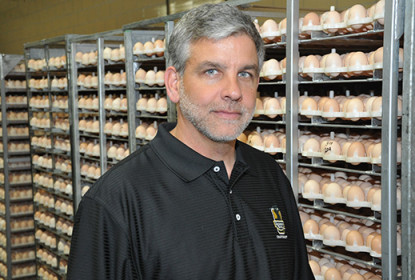
Biosecurity, Expert Advice, Global TOP NEWS, Infectious Diseases, News, PHT GLOBAL, PHT US, Respiratory, TOP NEWS
... Breaches in biosecurity: Sanderson Farms vet shares three valuable lessons
Nov 05, 2015Jennifer GrullonComments Off on Breaches in biosecurity: Sanderson Farms vet shares three valuable lessons
By Philip A. Stayer, DVM Corporate Veterinarian, Sanderson Farms, Inc.... New coccidiosis-management initiative aims to reduce losses
Oct 14, 2015Jennifer GrullonComments Off on New coccidiosis-management initiative aims to reduce losses
Targeting the global poultry industry’s more than $3 billion in annual losses to coccidiosis, Zoetis Inc. introduced a new, science-based initiative to help poultry producers worldwide develop...... Fine-tuning rotation plan can improve coccidiosis management
Sep 29, 2015Jennifer GrullonComments Off on Fine-tuning rotation plan can improve coccidiosis management
Broiler producers have made important strides in managing coccidiosis but could further improve control and cut losses by rethinking their strategy for anticoccidial rotation, say veterinarians who...... Are ionophores antibiotics? That depends on whom you ask
Sep 28, 2015Jennifer GrullonComments Off on Are ionophores antibiotics? That depends on whom you ask
In the EU — a market often perceived to be less tolerant of antibiotic use in food animals than the US — antibiotics used for growth promotion were banned in 2006. However, certain ionophores,...... Ionophores: The price of elimination
Sep 28, 2015Jennifer GrullonComments Off on Ionophores: The price of elimination
Published reports indicate that poultry operations not using any type of antibiotic, including ionophores, are indeed experiencing setbacks in production and flock welfare.... Complex broiler-vaccine decisions require expert advice
Sep 28, 2015Jennifer GrullonComments Off on Complex broiler-vaccine decisions require expert advice
Developing a vaccination program targeting optimal performance and return requires more planning and expertise than local “experts” at the farm store can offer.... High stocking density predisposes broilers to NE
Sep 28, 2015Jennifer GrullonComments Off on High stocking density predisposes broilers to NE
High stocking density has adverse effects on broiler welfare and intestinal health and predisposes the birds to necrotic enteritis (NE), according to the results of an experiment conducted by...... Sanderson’s Phil Stayer: ‘Sustainability is really nothing new for poultry’
Sep 20, 2015Jennifer GrullonComments Off on Sanderson’s Phil Stayer: ‘Sustainability is really nothing new for poultry’
Maintaining good intestinal health is particularly important for sustainability because the condition of the gut ultimately determines a flock’s growth rate and feed conversion.... ‘Rotate smarter,’ says coccidiosis specialist
Sep 19, 2015Jennifer GrullonComments Off on ‘Rotate smarter,’ says coccidiosis specialist
Poultry producers need to “rotate smarter” and learn the differences between anticoccidials if they want to maintain effective and sustainable coccidiosis-management programs, says well-known...... Sustainability: What on earth does it really mean? And how does it apply to poultry health?
Sep 10, 2015Jennifer GrullonComments Off on Sustainability: What on earth does it really mean? And how does it apply to poultry health?
In the poultry industry, sustainability trends are reshaping every link in the production chain. But what exactly does it mean for poultry to be “sustainable”?... Sustainability: What does it mean to poultry health?
Aug 27, 2015Jennifer GrullonComments Off on Sustainability: What does it mean to poultry health?
In agriculture, sustainability translates to producing more with less — a goal that morphs into a dire need when looking at global population trends. According to a recent UN report, food...... Eight ways to protect your farm from avian flu this fall
Aug 25, 2015Jennifer GrullonComments Off on Eight ways to protect your farm from avian flu this fall
To prepare for the avian flu this fall, the National Chicken Council (NCC) has identified eight biosecurity principles for broiler and broiler-breeder producers.... British vets question health, welfare of free-range chickens
Aug 25, 2015Jennifer GrullonComments Off on British vets question health, welfare of free-range chickens
While activists tout the happier, healthier life of free-range chickens, veterinarians in Great Britain have expressed concern about their long-term sustainability and increased likelihood of a major...... Vets treat chickens to prevent foodborne illness
Aug 18, 2015Jennifer GrullonComments Off on Vets treat chickens to prevent foodborne illness
In the latest episode of Vets on Call, Dr. Pohl and Dr. Chuck Hofacre of the University of Georgia visit a broiler farm to examine the flock’s response to a vaccine.... Poultry vets are latest focus of popular YouTube series
Aug 16, 2015Jennifer GrullonComments Off on Poultry vets are latest focus of popular YouTube series
The popular YouTube series, Veterinarians on Call, recently turned its cameras on two poultry veterinarians from the University of Georgia to help educate the public on modern poultry production.... Reducing false positives pays in ELISA mycoplasma testing
Aug 05, 2015Jennifer GrullonComments Off on Reducing false positives pays in ELISA mycoplasma testing
Poultry producers should consider specificity when selecting a Mycoplasma ELISA test to avoid costs associated with false positives.... Got maxima? New sampling procedure aids detection in broilers
Aug 04, 2015Jennifer GrullonComments Off on Got maxima? New sampling procedure aids detection in broilers
A modified sampling procedure developed by researchers at Zoetis Inc. has dramatically improved the detection of Eimeria maxima infection in broilers.... Flu panel examines US control efforts, impacts on trade
Aug 02, 2015Jennifer GrullonComments Off on Flu panel examines US control efforts, impacts on trade
With well over 200 outbreaks affecting more than 47 million poultry over the last six months, highly pathogenic avian influenza (HPAI) is hitting the US poultry industry hard.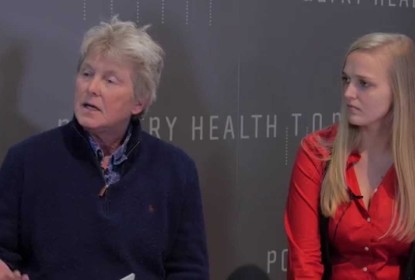
Diagnostics, Global TOP NEWS, Gut Health, ippe2015- Interviews with experts, News, PHT GLOBAL, PHT US, TOP NEWS, Videos
... Coccidiosis research yielding new perspectives on AST
Jul 30, 2015Jennifer GrullonComments Off on Coccidiosis research yielding new perspectives on AST
Adding molecular biology (PCR) to anticoccidial sensitivity testing (AST), offers a more in-depth look — and surprising findings — of Eimeria species contributing to coccidiosis in poultry...... Reality check: Technically, all poultry in the US is ‘antibiotic-free’
Jul 19, 2015Jennifer GrullonComments Off on Reality check: Technically, all poultry in the US is ‘antibiotic-free’
Confidently presenting facts can go a long way toward shaping consumer opinions about commercial poultry production and the importance of maintaining flock health, welfare and efficiency. For this...... Pathogens on farm and in processing related
Jul 13, 2015Jennifer GrullonComments Off on Pathogens on farm and in processing related
Salmonella and Campylobacter prevalence and loads on the farm are significantly associated with prevalence and loads of the same pathogens at processing.... Judicious drug use: The good, the bad and the ugly
Jun 29, 2015Jennifer GrullonComments Off on Judicious drug use: The good, the bad and the ugly
According to FDA, judicious use means administering an antimicrobial drug appropriately — and only when necessary.... FDA Releases Biannual Progress Report on Judicious Use of Antimicrobials in Food-producing Animals
Jun 22, 2015Jennifer GrullonComments Off on FDA Releases Biannual Progress Report on Judicious Use of Antimicrobials in Food-producing Animals
The U.S. Food and Drug Administration announced today its second progress report on its strategy to promote the judicious use of antimicrobials in food-producing animals.... Prevention claims essential for ensuring flock health, welfare
Jun 16, 2015Jennifer GrullonComments Off on Prevention claims essential for ensuring flock health, welfare
New FDA guidelines that discourage using medically important antibiotics for promoting growth in food animals appear to have been well-received by both producers and most consumer activists.... FDA issues rule requiring veterinary supervision of medically important antimicrobials
Jun 02, 2015Jennifer GrullonComments Off on FDA issues rule requiring veterinary supervision of medically important antimicrobials
The US Food and Drug Administration announced today its final rule for the Veterinary Feed Directive (VFD) — a move that is said to be “an important piece of the agency’s overall strategy to...... Poultry vet reviews nuts and bolts of FDA’s new antimicrobial guidelines
May 29, 2015Jennifer GrullonComments Off on Poultry vet reviews nuts and bolts of FDA’s new antimicrobial guidelines
FDA recently rolled out new voluntary guidelines for antimicrobial usage in poultry and livestock — not just how the medications are categorized and prescribed, but also how, when and why they...... What’s causing ‘woody breast’ in poultry?
May 28, 2015Jennifer GrullonComments Off on What’s causing ‘woody breast’ in poultry?
A condition known as “woody breast” is puzzling US poultry scientists investigating why breast-muscle tissue from some broiler flocks is hard and tough instead of tender and juicy.... Walmart, Sam’s Club announce new animal welfare, antibiotic positions
May 27, 2015Jennifer GrullonComments Off on Walmart, Sam’s Club announce new animal welfare, antibiotic positions
Walmart and Sam’s Club recently announced new positions on animal welfare and the responsible use of antibiotics in farm animals.... Ammonia concentration versus ventilation rate
May 26, 2015Jennifer GrullonComments Off on Ammonia concentration versus ventilation rate
Monitoring ammonia levels in poultry houses can help producers to adjust ventilation rates and thus prevent problems.
Global TOP NEWS, Infectious Diseases, ippe2015- Interviews with experts, News, PHT GLOBAL, PHT US, TOP NEWS, Videos
... Poultry vet urges poultry producers to guard against E. coli
May 21, 2015Jennifer GrullonComments Off on Poultry vet urges poultry producers to guard against E. coli
Long regarded as a secondary infection to respiratory disease, E. coli is now rated as a primary infection in many layer and broiler-breeder flocks, according to Jose Linares, DVM and technical...... Experience with GA 08 provides valuable information about IBV variants in poultry
May 08, 2015Jennifer GrullonComments Off on Experience with GA 08 provides valuable information about IBV variants in poultry
Experience with Georgia 2008 (GA 08) — the infectious bronchitis variant that’s caused major economic losses for poultry producers in the Southeast — has provided valuable information that will...... Media consultant: Let poultry vets tell the antibiotic story
May 07, 2015Jennifer GrullonComments Off on Media consultant: Let poultry vets tell the antibiotic story
The U.S. poultry industry needs to do a better job telling its story about antibiotics and their role in sustainable production and flock welfare, according to Frank Singleton, a media consultant...... Leading welfare, food-safety groups urge chicken Industry to reduce antibiotics responsibly
May 05, 2015Jennifer GrullonComments Off on Leading welfare, food-safety groups urge chicken Industry to reduce antibiotics responsibly
ASPCA (American Society for the Prevention of Cruelty to Animals) and Center for Food Safety: "Eliminating the routine use of [antibiotics] without addressing the birds’ underlying health problems...
Antibiotic-free, Global TOP NEWS, Gut Health, ippe2015- Interviews with experts, News, PHT GLOBAL, PHT US, TOP NEWS, Videos
... Poultry specialist offers tips for managing gut health through better nutrition
Apr 30, 2015Jennifer GrullonComments Off on Poultry specialist offers tips for managing gut health through better nutrition
Nutritionist Brett Lumpkins, PhD, of Southern Poultry Research, Athens, Georgia, talks about antibiotic-free poultry production, the challenges it presents and how rations can be adjusted for better...... Shrewd moves: Like a chess match, anticoccidial rotation is a game of strategy at Wayne Farms
Apr 29, 2015Jennifer GrullonComments Off on Shrewd moves: Like a chess match, anticoccidial rotation is a game of strategy at Wayne Farms
Your next move might address an immediate need, but it also could determine what pieces are still standing later in the match.
Global TOP NEWS, ippe2015- Interviews with experts, News, PHT GLOBAL, PHT US, Sustainability, TOP NEWS, Videos
... Defining, and demonstrating, sustainability in the poultry industry
Apr 22, 2015Jennifer GrullonComments Off on Defining, and demonstrating, sustainability in the poultry industry
Billy Hargis, PhD, University of Arkansas, thinks the US poultry industry has already set high standards for sustainability, but its efforts are largely misunderstood and unappreciated.... Studies demonstrate the benefits of dual-needle in ovo vaccine delivery
Apr 20, 2015Jennifer GrullonComments Off on Studies demonstrate the benefits of dual-needle in ovo vaccine delivery
by Taylor Barbosa, DVM, PhD, ACPV, Director of Outcomes Research, Zoetis Inc.... Broiler chicks show less tendon swelling, weight suppression in reovirus vaccine study
Apr 02, 2015Jennifer GrullonComments Off on Broiler chicks show less tendon swelling, weight suppression in reovirus vaccine study
A recent study showed that broiler chicks receiving higher reovirus antibody levels from conventionally vaccinated hens had a lower incidence of tendon swelling and were protected from weight...... Salmonella and coccidiosis: Is there a connection?
Mar 25, 2015Jennifer GrullonComments Off on Salmonella and coccidiosis: Is there a connection?
Chuck Hofacre, DVM, PhD, of the University of Georgia, talks about the relationship of salmonella and coccidiosis in poultry. He also offers tips for minimizing the presence of salmonella in live...... Industry roundtable: Raising poultry without antibiotics
Mar 19, 2015Jennifer GrullonComments Off on Industry roundtable: Raising poultry without antibiotics
Antibiotic-free poultry production remains uncharted territory that’s yielding varied results, a few surprises and an ethical dilemma for veterinarians, poultry experts said at an industry...... CDC turns to Yelp for tracking reports of foodborne illness
Mar 05, 2015Jennifer GrullonComments Off on CDC turns to Yelp for tracking reports of foodborne illness
The Centers for Disease Control (CDC) recently posted analysis of using the urban business-review site Yelp to identify unreported outbreaks of foodborne illness, reports the latest edition of...... White House forum targets antibiotic resistance, promotes responsible use in farm animals
Mar 05, 2015Jennifer GrullonComments Off on White House forum targets antibiotic resistance, promotes responsible use in farm animals
A recent White House forum on antibiotic stewardship brought together more than 150 key players from human and animal health constituencies in an effort to ensure responsible antibiotic use and...... Editorial: The animal doctor’s dilemma
Mar 05, 2015Jennifer GrullonComments Off on Editorial: The animal doctor’s dilemma
Today, some poultry veterinarians are being asked to avoid using antibiotics that have been reviewed, approved and licensed for use in poultry and other species by the US FDA.... FDA finds positive and negative trends in antimicrobial resistance in bacteria isolated from humans, retail meats and food animals
Mar 04, 2015Jennifer GrullonComments Off on FDA finds positive and negative trends in antimicrobial resistance in bacteria isolated from humans, retail meats and food animals
The Food and Drug Administration has released its National Antimicrobial Resistance Monitoring System (NARMS) 2011 Executive Report, showing both increasing and decreasing antimicrobial resistance...... ‘Location, location, location’ keys to successful in ovo vaccination
Mar 03, 2015Jennifer GrullonComments Off on ‘Location, location, location’ keys to successful in ovo vaccination
By Tarsicio Villalobos, DVM Director, Technical Service Zoetis Inc.... Link between fishmeal, Eimeria and necrotic enteritis in broilers explored
Feb 28, 2015Jennifer GrullonComments Off on Link between fishmeal, Eimeria and necrotic enteritis in broilers explored
Insights into how fishmeal in poultry rations and Eimeria infection may predispose broilers to necrotic enteritis come from a study by Australian investigators.... Avian influenza report from California underscores importance of biosecurity
Feb 09, 2015Jennifer GrullonComments Off on Avian influenza report from California underscores importance of biosecurity
Reports of AI on a California poultry farm in January 2015 underscore the importance of being vigilant with biosecurity, says Carl Heeder, DVM.
Antibiotic-free, Global TOP NEWS, Gut Health, ippe2015- Highlights from our latest issue, News, PHT GLOBAL, PHT US, Sustainability, TOP NEWS
... Roundtable highlights: Raising poultry without antibiotics
Jan 27, 2015Jennifer GrullonComments Off on Roundtable highlights: Raising poultry without antibiotics
Antibiotic-free poultry production remains uncharted territory that’s yielding varied results, a few surprises and an ethical dilemma for veterinarians, poultry experts said at an industry...... Keys to successful ABF production
Jan 22, 2015Jennifer GrullonComments Off on Keys to successful ABF production
Poultry health experts at a recent industry roundtable offered these suggestions for successful antibiotic-free production... What poultry is really raised without antibiotics?
Jan 22, 2015Jennifer GrullonComments Off on What poultry is really raised without antibiotics?
A variety of terms are used to describe poultry raised without antibiotics. Some are USDA approved and verified, but others are not. Here’s a look at what consumers are seeing in their meat cases,...... Sericea lespedeza found ineffective for coccidiosis control in chickens
Jan 22, 2015Jennifer GrullonComments Off on Sericea lespedeza found ineffective for coccidiosis control in chickens
Sericea lespedeza (SL), a warm-season legume shown to help control coccidiosis in lambs, had no anticoccidial activity in chickens, according to a study conducted at the University of Arkansas.... It’s back: Zoamix® adds flexibility to rotation plans
Jan 22, 2015Jennifer GrullonComments Off on It’s back: Zoamix® adds flexibility to rotation plans
Zoetis Inc. has relaunched Zoamix® (zoalene), a versatile synthetic anticoccidial for the prevention and control of coccidiosis in broilers and turkeys.... Coccidiosis: Why is it so difficult to manage?
Jan 22, 2015Jennifer GrullonComments Off on Coccidiosis: Why is it so difficult to manage?
With more than a dozen antimicrobials and a half dozen vaccines available for coccidiosis, why are US poultry producers still having such a difficult time managing this costly disease?... AAAP-AVMA antimicrobial guidelines stress good management, judicious use
Dec 15, 2014Jennifer GrullonComments Off on AAAP-AVMA antimicrobial guidelines stress good management, judicious use
Recent guidelines from the American Association of Avian Pathologists and the American Veterinary Medical Association outline the judicious therapeutic use of antimicrobials while focusing on the...... Doing a 180: A little education goes a long way toward changing customers’ attitudes about antibiotics
Dec 11, 2014Jennifer GrullonComments Off on Doing a 180: A little education goes a long way toward changing customers’ attitudes about antibiotics
Back in 2008, Pfizer Animal Health (now Zoetis Inc.) conducted market research to get a better handle on consumer opinions about the use of antibiotics...... Too busy for sustainability? Think again
Dec 04, 2014Jennifer GrullonComments Off on Too busy for sustainability? Think again
Sure, sustainability is a sound and noble concept — something everyone needs to think about and practice — but try telling that to a veterinarian or producer in the middle of an infectious...... Field trials show practical, economic benefits of E. coli vaccine in broilers
Nov 13, 2014Jennifer GrullonComments Off on Field trials show practical, economic benefits of E. coli vaccine in broilers
Recent studies on two continents have demonstrated that a modified-live vaccine reduced losses from Escherichia coli in broilers, even when the disease challenge was strong.... Let coccidiosis organisms ‘see something different’
Nov 06, 2014Jennifer GrullonComments Off on Let coccidiosis organisms ‘see something different’
Poultry producers are losing ground to coccidiosis because they’re not implementing effective rotation programs that employ different types and classes of anticoccidials, says Don Waldrip, DVM, a...... Facing poultry’s consumer trust challenge
Nov 06, 2014Jennifer GrullonComments Off on Facing poultry’s consumer trust challenge
Where does poultry stand with consumers on issues such as antibiotic usage, animal welfare and food safety? What must be done to strengthen trust in poultry and the companies that produce it? Five...... Poultry welfare – expectations and reality
Nov 06, 2014Jennifer GrullonComments Off on Poultry welfare – expectations and reality
Welfare of poultry, especially laying hens, has become a major issue for commercial poultry producers in the last 15 to 20 years. What is happening to the commercial egg business is also setting the...... Being more transparent: Media experts offer tips to poultry companies
Oct 30, 2014Jennifer GrullonComments Off on Being more transparent: Media experts offer tips to poultry companies
Between fast and easy Internet access, hundreds of cable channels, the explosion of social media, the rise of “citizen journalism” and the emergence of new digital news hubs and blogs, keeping...... Media specialist: ‘Get on the same message’ with poultry antibiotics, other topics
Oct 27, 2014Jennifer GrullonComments Off on Media specialist: ‘Get on the same message’ with poultry antibiotics, other topics
The poultry industry needs to “get on the same message” when talking about judicious antibiotic usage and other production topics, says Bryan Reber, PhD, a professor of public relations at the...... Life without antibiotics in poultry production
Oct 22, 2014Jennifer GrullonComments Off on Life without antibiotics in poultry production
U.S. poultry producers are using fewer and less antibiotics in broiler flocks as public concern over the use of antibiotics in food-producing animals intensifies.... Food industry consultant urges poultry industry to engage, educate customers through social media
Oct 20, 2014Jennifer GrullonComments Off on Food industry consultant urges poultry industry to engage, educate customers through social media
Today’s consumers are smarter, more engaged and “assume a certain amount of control over the things in their lives that they feel passionate about” says food industry consultant Frank...... Five ways to put sustainability into action today
Oct 16, 2014Jennifer GrullonComments Off on Five ways to put sustainability into action today
So how can commercial poultry producers make their poultry-health programs more sustainable — ethically, environmentally and economically?... Author of California bill defends using antibiotics to prevent disease
Aug 28, 2014Jennifer GrullonComments Off on Author of California bill defends using antibiotics to prevent disease
California lawmakers passed SB-835 (Food animals: medically important antimicrobial drugs), which mirrors the U.S. Food and Drug Administration's Guidance 213 (covered in Influence Feed edition "Real...... Zoetis receives full license for Georgia 08 IB vaccine
Aug 27, 2014Jennifer GrullonComments Off on Zoetis receives full license for Georgia 08 IB vaccine
Zoetis Inc. has obtained a full license from the USDA to sell Poulvac® Bron GA 08, the first commercially available vaccine to reduce disease caused by Georgia 2008 (GA 08) Type infectious...... Temperature of drinking water may affect bodyweight during brooding
Jul 19, 2014Jennifer GrullonComments Off on Temperature of drinking water may affect bodyweight during brooding
The temperature of drinking water during brooding may affect the bodyweight of broiler chicks, according to a University of Arkansas study.... S. enteritidis frequency in eggs similar in conventional and enriched cage systems
Jul 19, 2014Jennifer GrullonComments Off on S. enteritidis frequency in eggs similar in conventional and enriched cage systems
The frequency of egg contamination with S. enteritidis did not significantly differ between hens housed in conventional and enriched cages, investigators say in the March 2014 issue of Poultry...... Cracked corn has positive effect in broilers
Jul 19, 2014Jennifer GrullonComments Off on Cracked corn has positive effect in broilers
Cracked corn fed to broilers increased weight gain and gizzard size and had a positive effect on gut microflora, say New Zealand investigators.... Making sense of poultry labels
Jul 19, 2014Jennifer GrullonComments Off on Making sense of poultry labels
Demand for increased transparency has led to the proliferation of poultry labeling terms — many of which surface in discussions about sustainability and production practices. What these terms...... Timing may affect accuracy of in ovo vaccination
Jul 19, 2014Jennifer GrullonComments Off on Timing may affect accuracy of in ovo vaccination
The coccidiosis vaccine Inovocox® EM1 was more precisely deposited to embryos when the vaccine was administered at 18.5 versus 19 days of incubation, indicates a Zoetis-sponsored study from...... Editorial: Never say never
Jul 19, 2014Jennifer GrullonComments Off on Editorial: Never say never
Not that long ago, the thought of raising broilers on a large scale without ionophores or other intestinal health antibiotics would have seemed foolhardy. But that has changed in recent years, as...... Get the most from your ELISA tests
Jul 15, 2014Jennifer GrullonComments Off on Get the most from your ELISA tests
Andrea Zedek, a veterinarian at Zoetis Inc., offers tips for ensuring accuracy when using ELISA tests to diagnose a poultry flock's health status.... New FDA antibiotic guidelines: What’s a VFD?
Jul 04, 2014Jennifer GrullonComments Off on New FDA antibiotic guidelines: What’s a VFD?
The phrase Veterinary Feed Directive (VFD) may be new to poultry veterinarians and producers, but the process has actually been around since 1996, when Congress passed the Animal Drug Availability...... New FDA antibiotic guidelines: Why comply?
Jul 02, 2014Jennifer GrullonComments Off on New FDA antibiotic guidelines: Why comply?
FDA’s new antimicrobial guidelines are strictly voluntary — to a degree. In the agency’s own words, they “do not establish legally enforceable responsibilities”; they merely “describe the...... Feeling misunderstood? Vet urges producers to take action
Jul 01, 2014Jennifer GrullonComments Off on Feeling misunderstood? Vet urges producers to take action
Don’t blame consumers if they seem to have little understanding of modern poultry and livestock production. “It’s not their fault and it is not intentional. It is just the way society has...... Should antibiotics be used to prevent disease in poultry?
Jun 19, 2014Jennifer GrullonComments Off on Should antibiotics be used to prevent disease in poultry?
Using antibiotics to prevent — not just treat or control — certain diseases of poultry is a sensible, responsible and ethical practice, according to three veterinarians featured on an industry...... Coccidiosis: Why is it still so difficult to control?
Jun 12, 2014Jennifer GrullonComments Off on Coccidiosis: Why is it still so difficult to control?
Coccidiosis can be extremely difficult to manage in poultry because the organism that causes it "has a tremendous capability to reproduce and it's very resistant to any kind of attempt to destroy...... Intestinal health and necrotic enteritis in broilers
Jun 03, 2014Jennifer GrullonComments Off on Intestinal health and necrotic enteritis in broilers
Management at the farm level (litter quality and composition, lighting programmes, stocking density, drinker management and dietary feed management) are important to control necrotic enteritis,...... Reality check: Oft-cited antibiotic-usage figure mixes numbers from two reports
Jun 03, 2014Jennifer GrullonComments Off on Reality check: Oft-cited antibiotic-usage figure mixes numbers from two reports
Confidently presenting facts — not defensive rhetoric — can go a long way toward shaping consumer opinions about commercial poultry production and the importance of maintaining flock health,...... Reality check: 87% of antibiotics used in animals rarely used in human medicine
Jun 02, 2014Jennifer GrullonComments Off on Reality check: 87% of antibiotics used in animals rarely used in human medicine
Confidently presenting facts — not defensive rhetoric — can go a long way toward shaping consumer opinions about commercial poultry production and the importance of maintaining flock health,...... Reality check: Multidrug-resistant strains of Salmonella rare in humans
Jun 01, 2014Jennifer GrullonComments Off on Reality check: Multidrug-resistant strains of Salmonella rare in humans
Confidently presenting facts — not defensive rhetoric — can go a long way toward shaping consumer opinions about commercial poultry production and the importance of maintaining flock health,...... Antibiotic resistance revisited in recent media reports
May 27, 2014Jennifer GrullonComments Off on Antibiotic resistance revisited in recent media reports
Following the April 2014 World Health Organization (WHO) report warning of a “post-antibiotic era,” Current Biology published the findings of a new study on May 19, reports Influence Feed.... CDC releases progress report on food safety
Apr 28, 2014Jennifer GrullonComments Off on CDC releases progress report on food safety
The US Centers for Disease Control and Prevention (CDC) released a Foodborne Diseases Active Surveillance Network (FoodNet) report last week indicating that rates of Salmonella recently declined...... Supplemental bacitracin reduces mortality, C. perfringens in broilers
Apr 17, 2014Jennifer GrullonComments Off on Supplemental bacitracin reduces mortality, C. perfringens in broilers
Commercial broilers that received a bacitracin-supplemented diet had less Clostridium perfringens in their gut, according to researchers at Ohio State University.... Editorial: ‘To health!’
Apr 17, 2014Jennifer GrullonComments Off on Editorial: ‘To health!’
Welcome to Poultry Health Today, a new magazine we’re sponsoring to keep US producers, veterinarians and nutritionists on top of the latest developments in this critical area of production.... Impact of lighting types on broiler performance
Apr 17, 2014Jennifer GrullonComments Off on Impact of lighting types on broiler performance
A study at the University of Delaware shows that broiler performance in terms of breast and body weights was similar for two poultry-specific LED lamps and incandescent lamps and better than for... FDA issues update on antibiotic guidelines
Apr 13, 2014Jennifer GrullonComments Off on FDA issues update on antibiotic guidelines
The U.S. Food and Drug Administration (FDA) issued on March 26 an Update on Animal Pharmaceutical Industry Response to Guidance #213, which asked animal health companies to voluntarily phase out...... Remembering (and channeling) Dr. Scott Hurd
Apr 11, 2014Jennifer GrullonComments Off on Remembering (and channeling) Dr. Scott Hurd
The last time we talked with Iowa State University’s Dr. Scott Hurd, he was joyfully, if not playfully, musing about all the topics he could cover in his new blog for Poultry Health Today....... Poultry veterinarian shares ideas for managing coccidiosis more effectively, economically, sustainably
Feb 28, 2014Jennifer GrullonComments Off on Poultry veterinarian shares ideas for managing coccidiosis more effectively, economically, sustainably
Don Waldrip, DVM, talks about a new a new science-based, global initiative from Zoetis to help poultry producers develop longer term, sustainable management of coccidiosis.... Five federal bills seek to curb on-farm antibiotic use
Feb 13, 2014Jennifer GrullonComments Off on Five federal bills seek to curb on-farm antibiotic use
Although FDA has introduced new guidelines for using feed antibiotics in poultry and livestock, some members of Congress would like the industry to go a few steps further.... CDC: Widespread use of antibiotics in hospitals is leading cause of resistance
Jan 24, 2014Jennifer GrullonComments Off on CDC: Widespread use of antibiotics in hospitals is leading cause of resistance
The most important cause of antibiotic-resistant infections in people can be attributed to widespread antibiotic use in hospitals, according to the Centers for Disease Control and Prevention (CDC).... Rotecc™ coccidiosis management video
Jan 24, 2014Jennifer GrullonComments Off on Rotecc™ coccidiosis management video
Learn more about the new global coccidiosis-management initiative from Zoetis.... Methods of diagnosing enteric disease clarified
Jan 15, 2014Jennifer GrullonComments Off on Methods of diagnosing enteric disease clarified
Diagnosing clostridial enteric disease in poultry remains a challenge — primarily because many clostridial species can be a normal inhabitant of the gut, which makes it difficult to determine their...... Increased CVI988 vaccine use credited with decline in Marek’s disease
Jan 15, 2014Jennifer GrullonComments Off on Increased CVI988 vaccine use credited with decline in Marek’s disease
Increased use of CVI988/Rispens vaccines is credited with declines in the incidence of Marek’s disease (MD), according to investigators from USDA‘s Agricultural Research Service.... Single dose of Poulvac IBMM+Ark protects long-lived broilers for at least 9 weeks
Jan 15, 2014Jennifer GrullonComments Off on Single dose of Poulvac IBMM+Ark protects long-lived broilers for at least 9 weeks
One dose of the live, attenuated vaccine Poulvac® IBMM+Ark effectively protected broilers against two infectious bronchitis (IB) strains for at least 9 weeks, a recent study shows.... Better protection shown with recommended Marek’s disease vaccine dose in two genetic lines
Jan 15, 2014Jennifer GrullonComments Off on Better protection shown with recommended Marek’s disease vaccine dose in two genetic lines
The recommended dose of two Marek’s disease virus (MDV) vaccines provided better protection in two genetic lines of meat-type chickens compared to a lower dose, the results of a recent study show,...... Organic raw poultry not necessarily safer
Jan 15, 2014Jennifer GrullonComments Off on Organic raw poultry not necessarily safer
Organic raw poultry is not necessarily safer for consumption than conventionally raised poultry, indicates a study from the University of Tennessee.... New studies examine effects of lighting on chickens
Jan 14, 2014Jennifer GrullonComments Off on New studies examine effects of lighting on chickens
Two recent studies show that broilers perform better under LED lighting than fluorescent lamps while layer behaviour is affected by light wavelength.... Research review: What’s new in poultry housing and equipment?
Jan 03, 2014Jennifer GrullonComments Off on Research review: What’s new in poultry housing and equipment?
With animal welfare and the environmental aspects of food animal farming gaining more attention from the public and high feed prices focusing efforts on getting the best performance from poultry,...... Lameness in broilers: Osteomyelitis
Jan 01, 2014Jennifer GrullonComments Off on Lameness in broilers: Osteomyelitis
By Stephen Collett, BScAgric, BVSc, MMedVet, MRCVS, DACPV Poultry Diagnostic and Research Center, College of Veterinary Medicine, University of Georgia






